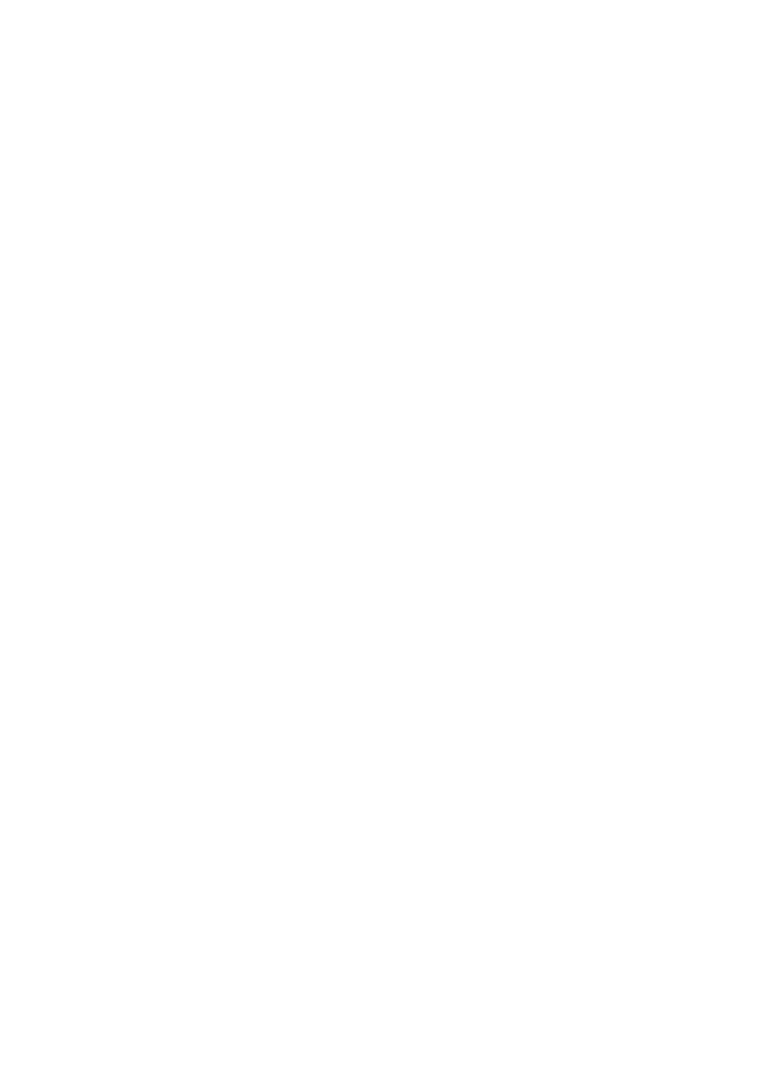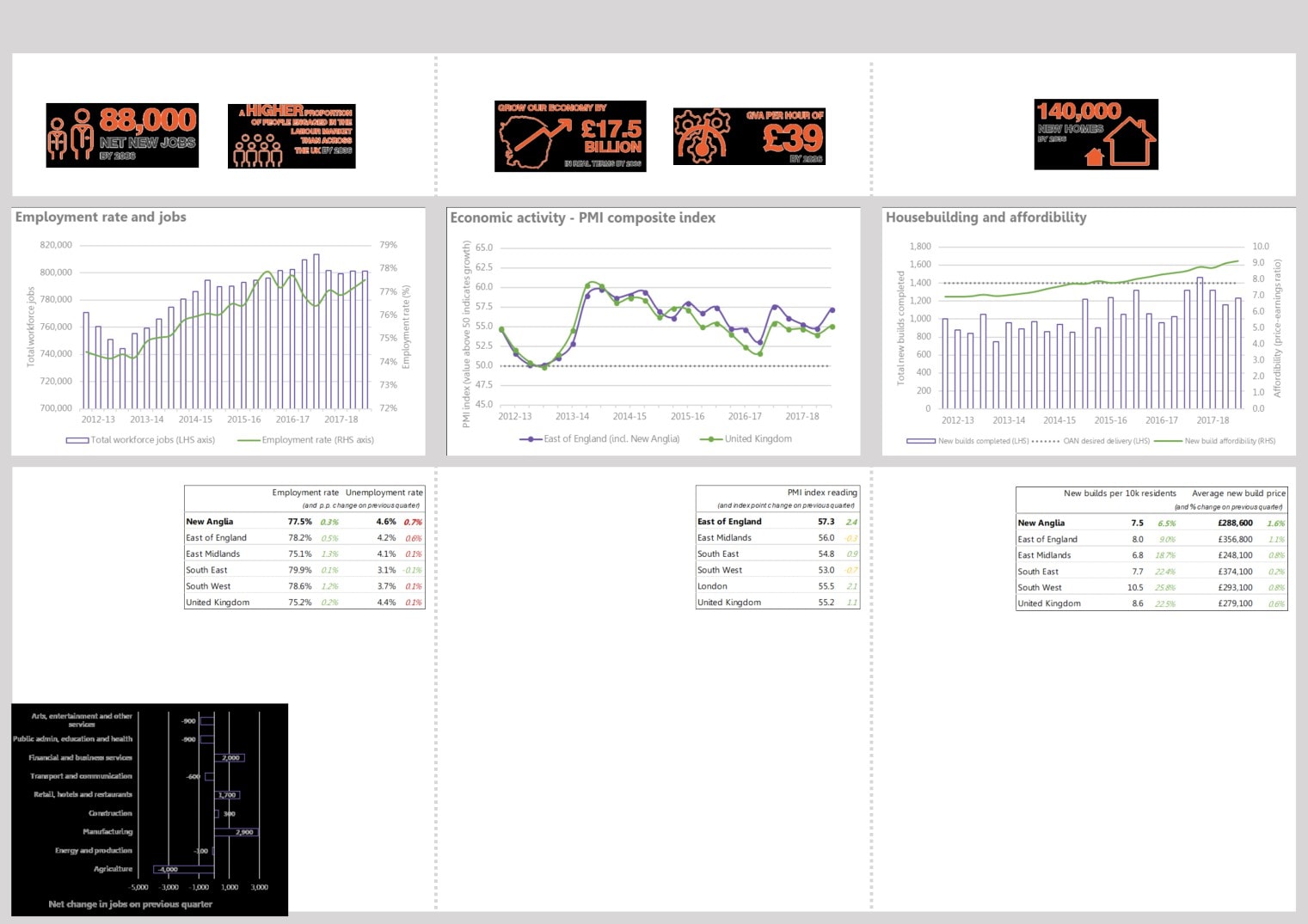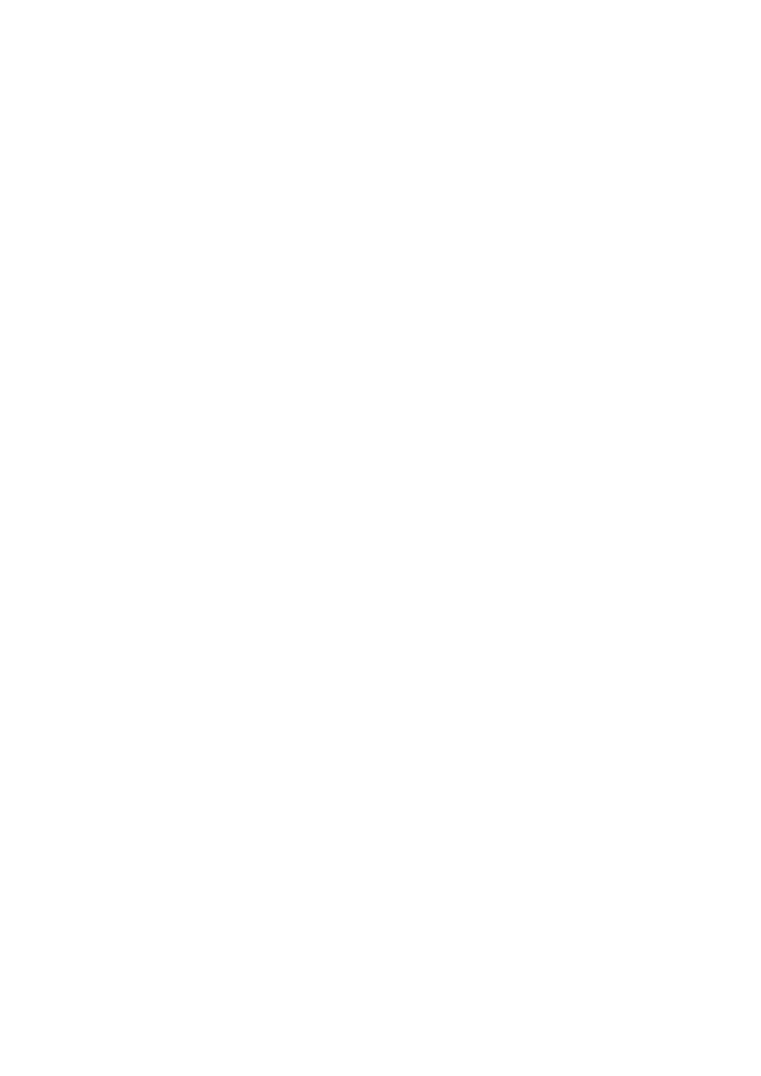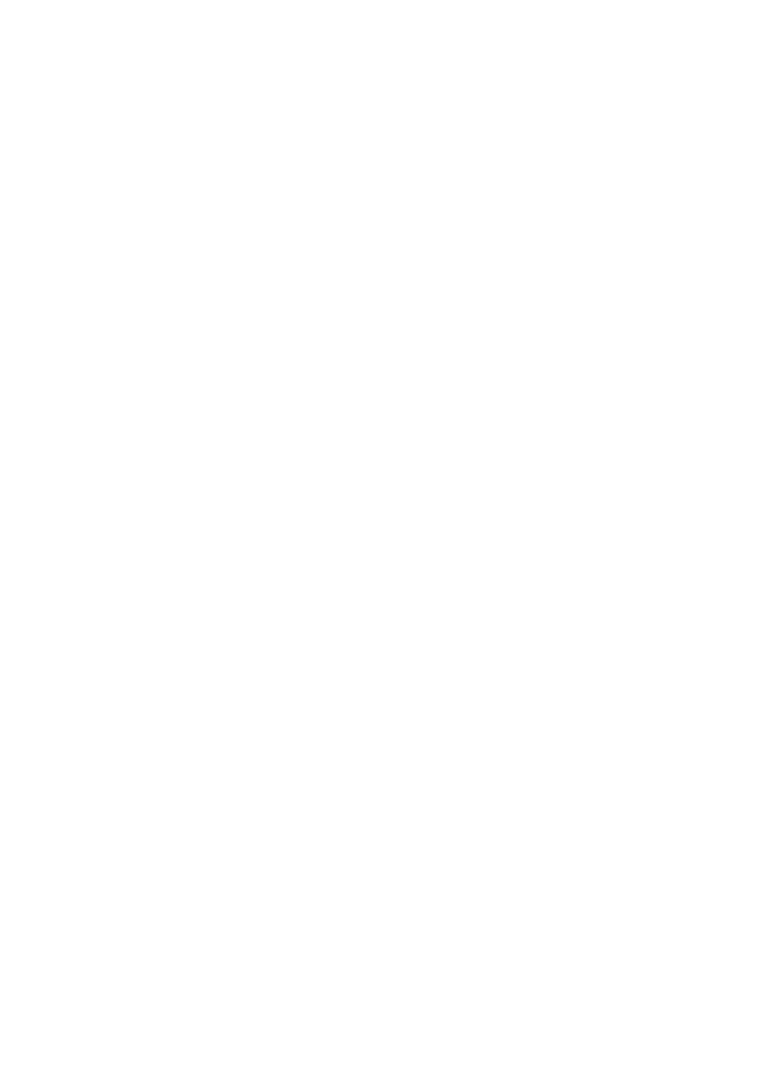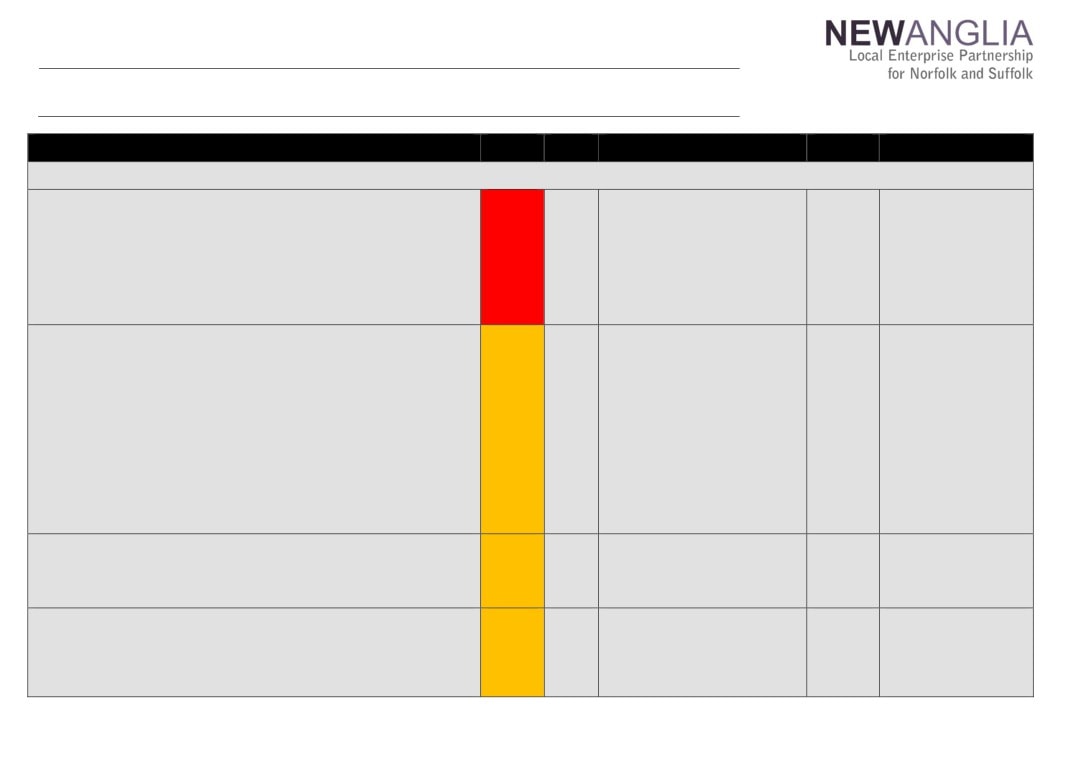New Anglia Local Enterprise Partnership Board Meeting
Wednesday 23rd May 2018
10.00am to 12.30pm
Co-op Education Centre, 11 Fore St, Ipswich IP4 1JW
Agenda
No.
Item
Duration
1.
Welcome and Introduction
15 mins
2.
Apologies
3.
Declarations of Interest
4.
Actions / Minutes from the last meeting including Decision Log
Forward looking
40 mins
5.
Integrated Transport Strategy
For Approval
6.
Enterprise Zones including a Confidential Appendix
Update
Break
10 mins
Governance and delivery
85 mins
7.
West Suffolk College Engineering Centre 2nd Phase
For Approval
8.
Capital Growth Programme Projects - Confidential
For Approval
9.
Speculative Development
For Approval
10.
Growing Places Fund - Atex Park Loan - Confidential
For Approval
11.
Data Dashboard
Update
12.
PwC Report - Review of Implementation
Update
13.
Chief Executive’s Report
Update
14.
Finance Report including a Confidential Appendix
Update
15.
Board Forward Plan
Update
16.
Any Other Business
Update
Date and time of next meeting:
10.00am - 12.30pm, 20th June 2018
Venue: The Council House, University of East Anglia, Norwich, NR4 7TJ
1
New Anglia Board Meeting Minutes (Unconfirmed)
18th April 2018
Present:
Cllr David Ellesmere (DE)
Ipswich Borough Council
Doug Field (DF)
East of England Coop
Cliff Jordan (CJ)
Norfolk County Council
Dominic Keen (DK)
High Growth Robotics
Colin Noble (CN)
Suffolk County Council
Johnathan Reynolds (JR)
Nautilus
David Richardson (DR)
UEA
Lindsey Rix (LR)
Aviva
Nikos Savvas (NS)
West Suffolk College
Jeanette Wheeler (JW)
Birketts
Tim Whitley (TW)
BT
In Attendance:
Sue Roper (SuR)
Suffolk County Council
Shan Lloyd (SL)
BEIS
Mike Stonard (MS)
Norwich City Council (For Alan Waters)
Tom Fitzpatrick (TF)
North Norfolk District Council (For Andrew Proctor)
Linn Clabburn
New Anglia LEP For Item 6
Chris Dashper (CD)
New Anglia LEP
Iain Dunnett (ID)
New Anglia LEP For Item 5
Chris Starkie (CS)
New Anglia LEP
Keith Spanton (KS)
New Anglia LEP
Helen Wilton (HW)
New Anglia LEP
1
3
Actions from the meeting: (18.04.18)
Chief Executive’s Report
To receive regional branding examples from Hayley Mace
HM
1
Welcome from the Chair
Doug Field (DF) welcomed everyone to the meeting and including Mike Stonard deputising for Alan
Waters and Tom Fitzpatrick deputising for Andrew Proctor.
2
Apologies
Apologies were received from: Andrew Proctor, Steve Oliver, Alan Waters, John Griffiths and Sandy
Ruddock.
3
Declarations of Interest
Declarations relevant to this meeting: Jeanette Wheeler - Item 8.
Chris Starkie (CS) reminded those deputising that a Declaration of Interest form needed to be completed
and returned to Charley Purves.
4
Minutes of the last meeting 21st February 2018
The minutes were accepted as a true record of the meeting held on 21st March 2018.
Actions from last meeting updated as follows:
Flood Defence Schemes
CD
Chris Dashper to produce a brief paper on LEP funding of flood defences to be circulated to
Board Members - Included in the Chief Executive’s Report
Institute of Technology
HM
Board members to be provided with details of the top 3 key messages from the LEP on a
monthly basis - An IoT brochure is being completed and will be circulated to Board members
when available.
5
Tri-LEP Local Energy East Strategy
Iain Dunnett (ID) provided the Board with a presentation on the work of the Local Energy East
Strategy.
Board members were advised that BEIS funding had become available nationally in March 2017
to establish Local Energy Networks and Strategies and that funding had been secured to cover
the tri-LEP area consisting of New Anglia, Greater Cambridgeshire and Peterborough and
Hertfordshire. This secured resources to produce a Local Energy Strategy supported by a
baseline of information including Energy Mapping, Analysis, Modelling, and the development of
a Web Portal.
The Strategy has identified four key priorities - Clean Economic Growth, Housing Growth and
Commercial Site Infrastructure, Secure, Affordable Low Carbon Consumption and Clean
Transport Networks including Electric Vehicles.
Work to date has included the mapping of energy assets across the counties which will assist
in producing a model to allow the faster planning and delivery of projects such as Snetterton
Heath.
ID noted that private sector involvement was limited and the hope was that joining investment
opportunities together would encourage more investment.
The Energy Strategy will be presented to the Board in May, which will be followed by the
release of a dedicated technical resource funded by BEIS for 2 years.
Mike Stonard (MS) asked whether the project would be funded after the initial 2 years. ID
advised that BEIS had proposed that the programme will be self-sufficient after 2 years but that
this issue needed to be considered and included in the plan.
2
4
Johnathan Reynolds (JR) noted that there was other tri-LEP work ongoing across other regions
which needed to be brought together and that this geographical grouping was based on the
power networks rather than LEP areas.
DF asked whether there was any impact from the winding up of GCGP. CS advised that this
had not caused any issues and that the Energy Strategy was on the forward plan for the new
Business Board for the Combined Authority.
The Board agreed:
To note the content of the presentation
6
Cambridge-Norwich Tech Corridor Presentation
Linn Clabburn (LC) provided the Board with an update on the progress on the Cambridge -
Norwich Tech Corridor.
The partnership was set up with the relevant LEPs and Local Authorities to investigate how
best to exploit the opportunities in the corridor which has been identified as a priority place in
the Economic Strategy. Studies have suggested that the area has the potential to deliver an
additional 26,000 jobs and add a further £2.75bn to the economy.
LC reviewed the vision for the Corridor and identified the tangible ambitions for the programme
noting that cross-cluster development was viewed as key to the development.
A private sector lead delivery group is being set up and LC asked Board Members for
suggestions on suitable business leaders to join the group.
Jeanette Wheeler (JW) asked how the CNTC can compete with the Cambridge - Oxford
corridor. LC confirmed that Cambridge were fully engaged in the initiative and proposed that
the CNTC could focus on presenting its own identity such as specialising in clean efficient
growth to compliment other corridors rather than competing with them.
LC noted that businesses were being involved in the process and were advising of their labour
requirements so that the project looked at a wide approach providing jobs across the full supply
chain rather than just highly skilled jobs.
Colin Noble (CN) advised that an A14 corridor had just been launched focussing on developing
exports and exploiting the opportunities to allow companies to increase exports. There is
scope for the corridors to work together to complement each other in their offering.
David Richardson (DR) advised that he had recently met with the new vice-chancellor of
Cambridge and looked that the USPs of Norwich, the UEA and Norwich Research Park as an
attractive terminus at the end of the corridor but stressed that it still required additional
investment.
Nikos Savvas (NS) and Tim Whitley (TW) noted the importance of the Tech Triangle including
Ipswich and felt that the national significance of the area should be stressed to central
Government in order to establish the East of England as an economic powerhouse.
The Board agreed:
To note the content of the presentation
To suggest private sector representatives to sit on the delivery group (to be submitted to
Helen Wilton)
7
LEP Capital Budget 2018/ 19 - Confidential
CS presented the LEP 2018/19 capital budget to the Board and provided further details of
larger ongoing projects.
The Board was advised that some projects had slipped and although work was looking at
bringing forward spend where possible this had always proved challenging historically.
CS reviewed the main points of the budget relating to the Growth Deals Programme, Growing
Business Fund, New Anglia Capital and Agritech.
CS requested the allocation of £1m of the Growing Places Fund budget to New Anglia Capital
to allow for further investments to be made.
3
5
CS advised the meeting that £1m had previously been allocated to Eastern Agritech and
requested that this allocation continue while discussions are ongoing with the Combined
Authority on the future of the programme and the production of a business plan.
JW queried why this was still being progressed with the Combined Authority and not
independently. CS advised that the programme could be continued alone but this was
originally set up as a joint bid out of the Regional Growth Fund. The panel also contains
technical expertise which would be lost if the work was not combined
TW asked who would approved the business plan - the IAC or the LEP Board. CS
recommended that the Board should approve the plan.
DR felt that the New Anglia LEP had not received sufficient credit for the Agritech programme
to date and that this new start provided the opportunity for New Anglia to take the lead.
This should be a pre-requisite of the business plan.
DF asked when the plan would be completed. CS confirmed that it was currently scheduled for
agreement at the June Board meeting.
The Board agreed:
To note the content of the budget
To approve the 2018/19 capital budget
To approve the allocation of £1m from the GPF fund budget to New Anglia Capital.
To approve the allocation of £1m to Agritech subject to the production and approval of a
business plan
8
Review of Professional Advisers
JW left the room.
CS reviewed the paper included in the meeting pack and reviewed the proposal to develop a
multi-supplier procurement framework.
DF asked who will be managing the process. CS confirmed that Rosanne Wijnberg will join on
1st May as COO and will be managing the process.
The meeting was advised that Lovell Blake will be used for the current audit but it is proposed
to carry out a re-tendering process for the following one.
David Ellesmere (DE) asked whether there would be various framework for the different areas
of work or a single one. CS advised that there would be multiple lists of advisors but it was
envisaged only to have one framework. Sue Roper (SuR) offered to provide assistance.
The Board agreed:
To approve the development of a supplier procurement framework
To carry out a retendering process for the audit
JW returned to the room.
9
Decision Log
CS highlighted the key points of the proposal to record the decisions of the various boards.
JR asked if there would be both confidential & non-confidential versions. CS agreed that the
confidential log would be added to Board papers and the non-confidential version would be
published on the web site.
It was agreed that this would start at the beginning of the 18/19 financial year at the start of
April 2018.
The Board agreed:
To approve adoption of the decisions log
10
Growth Deal Quarterly Dashboard
Chris Dashper (CD) presented the Growth Deal update report paper noting that only projects
with an Amber status were now included. The Board were advised that there are no issues with
the delivery of the projects however some were delayed.
4
6
CD reviewed the data contained in the Quarterly Dashboard which is submitted to Government
noting that this contained data from Q3 2017 and that some outputs were out of date as data
takes time to feed through to the dashboard.
CS noted that the data in the dashboard will always be a quarter behind and will be older that
the data supplied to Board members on a regular basis.
TW asked whether the outputs were on track to meet targets. CD advised that the outputs
were behind in some areas due to a mixture of delays in spend and delays in capturing the
outputs from projects where the funds have already been spent.
The Board agreed:
To agree the Quarterly Dashboard.
11
Chief Executive’s report including PwC Implementation Plan
CS reviewed the Chief Executive’s report and thanked CN for his involvement in the deep dive
in which the LEP had performed very well.
The Board were updated on the key points of the report.
ERDF bid - CS & DF met with MHCLG to discuss the bid and take action to address the delay.
Further information has been provided and the ESIF Committee will discuss the extension at a
meeting in the 3rd week in April.
JR queried the long term exit strategy. CS advised that the new UK Shared Prosperity will be
the initial source for requesting funding but other sources will be investigated. Shan Lloyd (SL)
advised that more information on the fund will be issued before the summer recess and that the
industrial strategy was a key part of this identifying how funding should be prioritised.
GEML - Pritti Patel has asked for the evidence based to be refreshed and work is ongoing to
produce a business case for infrastructure improvements.
East Branding workshop - JW updated the meeting on the workshop and the Board
discussed the importance of this work to the promotion of Norfolk and Suffolk. JW offered to
ask Hayley Mace to send details of examples of branding from other regions.
COO Recruitment - Rosanne Wijnberg will be starting on 1st May. CS advised Board
members of the broad scope of the division of responsibilities.
Structure Chart - revised structure chart was issued to Board members.
HR - CS updated the Board on the work Charley Purves has been carrying out on workplace
wellbeing.
David Ellesmere (DE) asked about the progress of the delivery of the Tier 2 of the Governance
review. CS advised that the LEP Executive would be progressing this as a priority but it had
been delayed slightly by the deep dive.
The Board agreed:
To note the content of the report
To receive regional branding examples from Hayley Mace
HM
12
Finance Report
Keith Spanton (KS) reviewed the key points of the paper and asked for questions from the
Board.
The Board agreed:
To note the content of the report
13
Board Forward Plan
CS reviewed the items to be covered at the May Board.
The Board agreed:
To note the content of the report
14
Any Other Business
DF advised the board of recent events promoting businesses in the region.
JW noted that the MAC Interim report needed to be included in the Brexit analysis and planning.
5
7
Next meeting:
Date and time of next meeting:
10.00am - 12.00pm, 23rd May 2018
Venue: Co-op Education Centre, 11 Fore St, Ipswich IP4 1JW
6
8
Actions from New Anglia LEP Board Meetings
Date
Item
Action
Update
Actioned By
Status
18/04/2018
Chief Executive’s Report
To receive regional branding examples from Hayley Mace
HM
Complete
21/02/2018
Declarations of Interest
Ascertain whether regular Board substitutes need to complete
Declarations will be required. Charley Purves will
CS
Complete
Declaration of Interest Forms.
contact Board substitutes to arrange completion
21/02/2018
Economic Indicator
To receive a paper on CO2 reductions for
CS and JR liaising
CS/JR
On-Going
Trajectories and Targets:
consideration of inclusion in the economic strategy targets
21/02/2018
Brexit Analysis
To receive an action plan detailing the next steps, timescales and measures of
Draft action plan is being produced & will be
LiR
On-Going
success
presented at the September Board meeting
22/11/2017
Business Performance
To receive a proposal on the Eastern Agi-Tech initiative by email.
CS has written to the Combined Authority and is
CS
On-Going
Reports
now liaising over a paper which will go to the June
Combined Authority Board meeting
9
New Anglia Local Enterprise Partnership
Board Decision Log
Date
Decision
Decision Made
Making Body*
02/05/2018
Growing
The Panel approved the following applications:
Business Fund
Warren Services Limited - Agreed to Support
Panel
Approved Grant: £32,000
Food Forensics Limited - Agreed to Support
Approved Grant: £36,980
Renvale Limited - Agreed to Support
Approved Grant: £184,552
18/04/2018
LEP Board
The Board made the following decisions:
LEP Capital Budget 2018/ 19 - Confidential
To approve the 2018/19 capital budget
To approve the allocation of £1m from the GPF fund budget to New Anglia Capital.
To approve the allocation of £1m to Agritech subject to the production and approval of a business plan
Review of Professional Advisers
To approve the development of a supplier procurement framework
To carry out a retendering process for the audit
Decision Log
To approve adoption of the decisions log
Growth Deal Quarterly Dashboard
To agree the Quarterly Dashboard.
18/04/2018
Investment
The IAC made the following decisions:
Appraisal
West Suffolk College Engineering and Technology Centre
Committee
It was agreed that the proposal would be presented at the LEP board meeting on the 23rd May 2018 for the release of the remaining
£3m to West Suffolk College Engineering and Technology Centre
Any Other Business
Cash Deposits - It was agreed that funding would be deposited until drawn down by the approved projects
11/04/2018
Remuneration
The Committee made the following decisions:
Committee
360-degree feedback - The committee agreed that this would be used initially with the CEO in August 2018.
CEO Objectives - Current CEO objectives were agreed by the committee
* New Anglia Local Enterprise Partnership Board, Investment Appraisal Committee, Growing Business Fund Panel, Remuneration Committee, Audit & Risk Committee
10
04/04/2018
Growing
The Panel approved the following applications:
Business Fund
Computer Service Centre Ltd - Agreed to support
Panel
Approved Grant: £265,800
Panel Graphics Ltd (2) - Agreed to support
Approved Grant: £64,414
Broadway Colours Ltd - Agreed to support
Approved Grant: £40,000
* New Anglia Local Enterprise Partnership Board, Investment Appraisal Committee, Growing Business Fund Panel, Remuneration Committee, Audit & Risk Committee
11
New Anglia Local Enterprise Partnership Board
Wednesday 23rd May
Agenda Item 5
Integrated Transport Strategy for Norfolk and Suffolk
Author: Ellen Goodwin
Summary
This report seeks Board approval to adopt the Integrated Transport Strategy for Norfolk and
Suffolk.
It also outlines the next steps with regard to launching the strategy, developing an associated
delivery plan and how we ensure full integration with the developing work programme of the
newly formed Transport East, which covers a wider East of England geography
Recommendation
The Board are asked to:
Adopt the strategy as a supporting strategy for the Norfolk and Suffolk Economic
Strategy; and
Endorse the relevant next steps and provide a steer as to direction going forward.
Background
Working with our partners, good progress has been made in unlocking the growth potential of
The East through targeted transport and digital investment.
However, the absence of a well-evidenced and clear transport strategy setting out the capital
investments needed to fully realise the economic potential of The East has been recognised by
the Local Transport Board and our partners.
It was also noted by the Department for Transport’s Executive Committee when they visited the
area in October 2016. A number of other regions, including Transport for the North, have
already attracted significant interest and investment from Government on the basis of similar
initiatives.
The New Anglia Local Transport Board commissioned WSP, Norfolk County Council’s partner
consultant, who have produced similar well-regarded work for Transport for the North (amongst
others), to develop an Integrated Transport Strategy, with supporting technical evidence, to look
at how the two counties’ economies might develop and the transport interventions needed to
support this.
The Strategy looks forward to 2050 and sets out the context for short, medium and longer-term
capital investments to support economic growth in Norfolk and Suffolk.
1
13
The development of the strategy has been funded jointly by Norfolk County Council, Suffolk
County Council and the LEP.
The work has been co-developed through a funders reference group, working closely with the
Local Transport Board who provided governance and direction for the work. Close liaison with
Norfolk and Suffolk Chambers of Commerce and with District Council partners has also
occurred as part of the stakeholder engagement plan.
The Integrated Transport Strategy was endorsed at the Local Transport Board meeting on 23
February 2018, Norfolk Chamber of Commerce on 9 April 2018, Suffolk Chamber of Commerce
on 17 April 2018, Suffolk County Council’s Cabinet on 15 May 2018 and is due to be endorsed
by Norfolk County Council’s Environment, Development and Transport Committee on 18 May
2018.
A final draft of the Strategy is attached as Appendix 1 for the LEP Board’s consideration and
approval.
Key Considerations
The Board are asked to adopt the Norfolk and Suffolk Integrated Transport Strategy noting the
stakeholder engagement and endorsement that has occurred during its development. It is also
asked to consider the next steps described below.
The Board has already committed budget to this project. No further contribution is being
sought.
Link to the Economic strategy
The Integrated Transport Strategy has been developed so that it fully aligns with the Norfolk
and Suffolk Economic Strategy through mapping connectivity and Economic Strategy themes
accordingly.
It will contribute to the delivery of the high-level ambition that Norfolk and Suffolk be a well-
connected place. It will also contribute to, albeit to a lesser extent, all of the other key
ambitions in the Strategy.
Next Steps and Key Dates
Strategy Launch
Ideally the Launch will be linked to another event in order to maximise impact. Members of this
Board, Local Authorities and the Local Transport Board will be invited. The launch will also
invite the DfT executive committee back to our area, as well as local MPs. The Board is asked
for their thoughts regarding other possible promotional events.
Delivery Plan
A supporting Delivery Plan will be developed and published alongside the Norfolk and Suffolk
Economic Strategy.
Transport East
The next meeting of Transport East is scheduled for 4 June 2018 and the Integrated Transport
Strategy will form a crucial building block for the Strategy they produce.
The Integrated Transport Strategy has the potential to attract investment into the region to
secure transport improvements in support of the economy both through local lobbying and
advocacy and via the newly formed Transport East Forum.
Recommendation
2
14
The Board are asked to:
Adopt the strategy as a supporting strategy for the Norfolk and Suffolk Economic
Strategy; and
Endorse the relevant next steps and provide a steer as to direction going forward.
Appendices
Appendix A - Integrated Transport Strategy for Norfolk and Suffolk
3
15
New Anglia Local Enterprise Partnership Board
23rd May 2018
Agenda Item 6
Enterprise Zones: Progress Update
Author: Julian Munson/Eunice Edwards. Presenter: Julian Munson
Summary
To provide a progress update report on New Anglia Local Enterprise Partnership’s two
Enterprise Zones;
1. Great Yarmouth & Lowestoft (New Anglia) Enterprise Zone (started 2012) & extensions
(started 2017).
2. Space to Innovate Enterprise Zone (started 2016).
This report will cover Enterprise Zone outputs to date, a financial analysis of income generated
to date, strategy, timeline and forward plan for delivery (to 2021).
Recommendation
The Board is asked to note progress and endorse the proposed strategy and forward plan.
Background
New Anglia LEP successfully bid to Ministry of Housing, communities and Local Government
(MHCLG) for two ‘multi-site’ Enterprise Zones in Norfolk & Suffolk.
Enterprise Zones are designated areas that provide business rates discounts of up to £275k
over a five year period to businesses if locating in the zones in the first 5/6 years & simplified
planning. Enterprise Zones are part of the Government’s wider Industrial Strategy to support
businesses and enable local economic growth.
The Great Yarmouth & Lowestoft Enterprise Zone began in April 2012 & encompasses six
sites; Beacon Park in Gorleston, South Denes in Great Yarmouth, Riverside Road in Lowestoft,
Mobbs Way in Oulton, South Lowestoft Industrial Estate in Lowestoft and Ellough in Beccles.
Four of these sites (Beacon Park, South Denes, Mobbs Way and Riverside) were also awarded
extensions where benefits started in 2017. This Enterprise Zone has an energy sector focus.
The Space to Innovate Enterprise Zone began in April 2016 and encompasses 10 sites;
Norwich Research Park, Suffolk Park in Bury St Edmunds, Scottow Enterprise Park near
Coltishall, Egmere Business Zone near Wells-next-the-Sea, Nar Ouse Business Park in King’s
Lynn, Stowmarket Enterprise Park and the 4 sites in the Ipswich area are Princes Street, Futura
Park, Waterfront Island and Sproughton Road (Swich Park). The sectors identified for this
1
17
Enterprise Zone include: agritech, food and health, offshore energy, the green economy, ICT
and digital creative sectors in which Norfolk and Suffolk has a competitive advantage.
Enterprise Zones have established themselves as a driving force of local economies as they
unlock key development sites, consolidate infrastructure, attract business and create jobs.
Both EZ’s have long range stretch targets they are working towards with annual targets set with
local authority partners each year. However progress to date on some sites has been slower
than expected. More details can be found at Appendix 1 - Enterprise Zones Targets to 2021.
Outputs are recorded and reported on a quarterly basis to MHCLG and New Anglia LEP Board.
Activity across the two Enterprise Zones is coordinated by two partnership/ development
groups, chaired by New Anglia LEP, involving County and District/Borough Council officers and
MHCLG.
In Summary, to date, the Great Yarmouth & Lowestoft Enterprise Zone has delivered 1,694
Jobs,
773 construction jobs,
50 businesses,
£44m private investment,
£178m public
investment, 18.3ha land developed & 52,223SqM floor-space.
To date the Space to Innovate Enterprise Zone has delivered 438 Jobs, 1,145 construction jobs,
72 businesses,
£14m private investment, £105m public investment, 13ha land developed and
9,170 SqM of floor-space.
All business rates growth generated by the Enterprise Zones are kept by the relevant Local
Enterprise Partnership and local authorities in the areas for 25 years to reinvest in local
economic growth. This reflects the Government’s commitment to long-term economic growth
and enables LEPs to reinvest in site development and other local initiatives.
The 100% retained rates is split into 4 separate funds;
Fund A1 is for the Collecting (or District) Authority
Fund A2 is for the County Council
Fund B is for the development of the Enterprise Zone sites
Fund C is for New Anglia LEP to fund activity in the Economic Strategy for Norfolk and Suffolk.
Please see Appendix 2 New Anglia Enterprise Zones Finances for more information
Key Considerations
Enterprise Zones remain a key priority programme for New Anglia LEP. They not only
demonstrate an effective method of intervention to unlock and accelerate the development of
key commercial sites but also support local economic development and job creation. In
addition they also enable the retention of business rates income to further enhance the
development and delivery of sites and provide an additional source of income for New Anglia
LEP for other project activity.
This programme has proven to be effective in unlocking and accelerating commercial
development in the Great Yarmouth and Lowestoft Enterprise Zone and in the case of the
Beacon Park site for example has had a highly significant impact on business investment and
jobs growth for the energy sector supply chain in that area.
There is progress on the majority of the Space to Innovate Enterprise Zone sites but it is
important that New Anglia LEP continues to work closely with partners to ensure that we
identify creative ways of removing any barriers to development and provide an even stronger
focus on delivery over the next couple of years. There are cases where development has been
limited and the issue of land ownership and level of ambition to build can be a major factor
inhibiting progress. The New Anglia LEP with Local Authority partners has the potential to help
2
18
overcome these barriers through the new EZ Accelerator Fund and opportunities around land
acquisition and co-investment to help ‘kick start’ new development.
It is also important that the Enterprise Zones ‘offer’ is more proactively marketed through
various channels and leveraging the Growth Hub, Growth Programme and inward investment
activity in a more coordinated and targeted way.
It is also important to note that a priority for Enterprise Zones is encouraging a net increase in
investment, business growth and job creation and so careful consideration is always given to
minimising ‘displacement’ within the locality of all enterprise zone sites.
Link to the Economic strategy
The New Anglia Enterprise Zone sites are all located in the Priority Places identified with the
new Economic Strategy. These include the Ipswich area, Norwich area, Norfolk/Suffolk Energy
Coast
(including North Norfolk, Great Yarmouth and Lowestoft areas), A14 Corridor
(Stowmarket and Bury St Edmunds) and the A47 Corridor (King’s Lynn).
As an incentive based programme focused on unlocking and delivering growth on key
commercial sites, Enterprise Zones support the objectives of the following priority themes;
Our Offer to the World (inward investment and trade support)
Driving Business Growth and Productivity (clustering, enhancing supply chain
activity, promoting innovation, targeting business support etc)
Collaborating to Grow (partnership activity to unlock development and delivery)
Competitive Clusters, Close to Global Centres (development and promotion of
innovative business clusters)
Next Steps
The proposed strategy and forward plan for Enterprise Zones to 2021 is outlined as follows;
May/June 2018 - desktop review of all enterprise zone sites, identifying progress status,
key issues, barriers to development, investment potential and opportunities etc.
July/August 2018 - update EZ site delivery plans and timelines (as a result of review)
July 2018 - sign off of outstanding legal agreements
August - December 2018
- Development of inward investment delivery plan (part of the Economic Strategy)
with specific objectives for attracting businesses to enterprise zone sites
September 2018 - December 2019
- Development and promotion of a joint package of potential business grant/loan
support for enterprise zone based businesses
- Enhanced promotion of enterprise zone sites at MIPIM UK event
- Promotion of business case studies (focus on innovative businesses)
- Targeted, direct marketing to expanding businesses via Growth Hub, Local
Authorities, Chambers of Commerce, Sector Groups, DIT, property agents etc
- Enhanced promotion of the enterprise zone sites via the inward investment
activity e.g. Invest Suffolk, Locate Norfolk, Tech Corridor and Invest East activity
3
19
- Active progression of potential Enterprise Zone Accelerator funded projects
working with Local Authorities (development of infrastructure and new buildings)
The New Anglia LEP has the responsibility of progressing this strategy and activity, in
partnership with Local Authorities, land owners and developers.
Recommendation
The Board is asked to note progress and endorse the proposed strategy and forward plan.
Appendices
Appendix 1 - EZ Targets
GY&L to 2021
S2I to 2021
Appendix 2 - New Anglia EZ Finances
Graph of income for both EZs - Fund A1, A2, B & C split
4
20
Appendix 1 - Enterprise Zones targets to 2021
Space to Innovate Enterprise Zone
2018-2021 (3 year period)
Construction
Private Capital investment
Jobs
Businesses
jobs *
£M
NRP
909
6
102
20
Nar Ouse
695
28
238
5
Suffolk BP
375
8
255
10
Stowmarket
205
20
102
2
Scottow
236
24
17
1
Egmere
43
9
34
2
Futura Park
296
9
255
10
Princes Street Total
417
2
85
5
IBC
-
-
-
-
141-145
-
-
-
-
Fisons
417
2
85
5
Island site
63
12
13
4
Sproughton
249
6
255
12
TOTALS S2I
3,488
124
1,356
£71M
Great Yarmouth & Lowestoft (New Anglia EZ)
2018-2021 (3 year period)
Construction
Private Capital investment
Jobs
Businesses
jobs*
£M
GY sites
558
10
119
6
WDC sites
708
20
85
4
TOTALS GY & L
1,266
30
204
10
EZ TOTAL
4,754
154
1,560
£81M
*Construction jobs. MHCLG requirements;
Permanent paid full time equivalent construction jobs that are newly created in connection with
the Enterprise Zone i.e. that did not exist before this quarter. A "permanent" job is expected to
last 26 weeks or more.
21
New Anglia Local Enterprise Partnership Board
Wednesday 23rd May 2018
Agenda Item 7
Engineering and Technology Centre, West Suffolk College (Vinten’s Building)
Author: Natasha Waller & Michael Gray. Presenter Chris Dashper
Summary
This paper seeks approval by the LEP Board of a £3m investment from the Growth
Deal towards the development of an Engineering and Technology Centre at West
Suffolk College.
This will be the second phase of a £7m LEP investment in the centre. £4m was
previously provided by the LEP to acquire the site and 9000m2 premises in 2016.
The £3m will be used to refurbish at least 3000m2 of the building so that it is fit to
deliver training in areas required by key sectors of our local economy.
The project will result in 536 additional learners over the first four years. 246 of which
will be engineering courses at level 3 and above.
Acquisition and refurbishment of the site provides the potential to unlock further
strategic opportunities.
Recommendation
To approve the release of the remaining £3m, originally allocated through the Skills Capital
funding application process, for the refurbishment of part a building in order to create a new
Engineering and Technology Centre at West Suffolk College.
Background
In
2014, as part of the then skills capital allocation process the New Anglia Skills Board
prioritised a £7m investment for the acquisition, modernisation and refurbishment of premises
within walking distance of the main West Suffolk College (WSC) campus to be used for full-time
further and higher education provision for the energy, engineering and advanced manufacturing
sectors. This building was acquired from Vitec who are relocating to other premises in the town.
As the current college campus have limited capacity to grow curriculum areas including their
ability to demonstrate engineering principles on a practical basis, the project was approved to
enable growth and improve the quality of the college’s offer in these key economic areas. The
project also represented a unique opportunity to secure land and property on the periphery of
the main WSC campus.
Following the prioritisation of the project by the Skills Board, WSC was invited to submit a
detailed application to ensure full due diligence was applied before funding was granted and to
help inform the final decision to be made by the LEP Board.
During this process it was decided that the project would be split into two distinct phases.
1
23
The first, to acquire the site, and the second to undertake modernisation and refurbishment.
This was due to both the annual allocation timescales of the Growth Deal allocation from
Government and the level of detail available at that point regarding the refurbishment due to the
commercial sensitivity of purchasing the building from the Vitec company.
In January 2016, the LEP invested £4m to acquire the site.
It was expected that the previous owners would be able to vacate the site earlier than has been
the case. With the purchase of the site the previous owners of the site became tenants, with
West Suffolk College receiving a rental income. This rental income (£669,000) has been ring
fenced and will be invested back into the development of the centre, either increasing the levels
of refurbishment due to take place or helping to cover any increase in refurbishment costs.
The LEP Board is now asked to approve release of the remaining £3 million of Growth Deal
funding previously ringfenced for the modernisation and refurbishment of the building.
The £3m grant will be used by West Suffolk College to fund the necessary modifications of a
proportion of the premises. This includes the discharging/meeting the planning conditions,
improving the building façade and creating the teaching spaces required including six higher
education engineering classrooms complimented by demonstration areas providing students
with a more ‘hands-on’ enhanced experience - vital for employability.
There will also be the creation of professional training facilities within three rooms in the centre
specifically designed to meet employers demands for targeted higher-level skills training for
their workforce.
The investment is expected to enhance the regional engineering and STEM provision offer. It
will result in at least an additional 536 learners over the first four years:
- 246 of which will be engineering courses at level 3 and above.
- 290 across ICT, business management, science and health and social care due to releasing
classroom space at the main campus.
This growth is expected to continue beyond the initial four years.
Acquisition and refurbishment of the site also provides the potential to unlock strategically
important opportunities to further enhance the regional training offer in important areas.
The Engineering and Technology Centre is an integral part of the bid to establish an
Institute of Technology in the East (EIoT), providing the space and industry standard
facilities to deliver the Institute’s higher level technical engineering curriculum.
There are many large-scale engineering/ technology and infrastructure projects planned for the
area that are of national significance which will substantially drive demand for high value skills
beyond current levels such as offshore wind, offshore decommissioning and the potential
Sizewell C and Bradwell B nuclear new builds. Many of the organisations involved in these
developments are supporting partners of the EIoT bid and will be working with WSC to support
the development and delivery of its curriculum.
This facility could potentially become part of a National College for Nuclear proposal, providing
many of the core technical skills that will be required for constructing and operating a Nuclear
Power Facility. WSC are also in dialogue with the Advanced Manufacturing Centre in Coventry
to become a ‘spoke’ site that would lead to innovative manufacturing and productivity solutions
for employers.
2
24
These developments will take place in the refurbished area if approved plus in the remaining
6000m2 of the site which will fall outside of this part of this current application. It is fully
anticipated that this area will be developed without further LEP funding.
Key considerations
£4m has already been committed to the Centre and spent to purchase the site and the rental
income has been ring fenced to go back into this project. £1 million has been committed by the
College to support the proposal. This was previously agreed by the LEP Board and approved
by the government appraisal process.
Timescales, vision and costings have all evolved since the original concept and proposal to the
Board but the college is committed to the Science, Technology, Engineering and Maths (STEM)
agenda and this is part of process of developing this curriculum for the region.
A full building inspection has not been carried out to date due to restriction issues with the
original owner who then became a tenant. This may lead to further costs in creating a safe
teaching environment. This is in addition to the known change of use redevelopments already
identified by planning regulations.
The college is clear that there will be no additional funds available from the LEP to cover any
contingencies if costings increase dramatically for the area of the building identified in the
Detailed Application Form (dated 16/03/2018).
West Suffolk College has agreed to cover these costs or review the level of resourcing. A Grant
Agreement would be put in place to secure this position. The college has a strong history of
financial management and monitor reserves robustly. Any further delay risks increasing costs
and delay in revenue from increased student capacity.
Link to the Economic Strategy
This new facility will support the growth in numbers of engineering students that are able to be
trained at the college. Advanced Manufacturing and Engineering & Energy are key sectors for
the LEP and the recently endorsed sector skills plans highlight a clear need for increase in
numbers of entrants to these sectors and an upskilling of the existing workforce.
This building also has areas earmarked for the proposed Eastern Institute of Technology and if
successful, funding will support further development over the coming years. Expansion of the
curriculum will also occur together with establishment of stronger links with other educational
providers in the region and key employers. Some of this is already underway and some new
equipment has been part funded through the Skills Deal which will be housed here. Training
has also been offered by an employer to improve the social mobility of a number of individuals
referred by the DWP showing that this building will clearly drive inclusion and skills.
The release of classroom space in the main college will allow other curriculum to grow as well -
Health & social care, Science, ICT and Business Management.
Next Steps
Grant agreement will be developed and signed.
Further structural reviews will be carried out and building work commissioned.
Centre to be operational for the 2019/20 academic year.
Further STEM based proposals to be developed for the unoccupied area.
Recommendation
To approve the release of the remaining £3 million, originally allocated through the Skills
Capital funding application process, for the refurbishment of part a building in order to create a
new Engineering and Technology Centre at West Suffolk College.
3
25
New Anglia Local Enterprise Partnership Board
Wednesday 23rd May 2018
Agenda Item 9
New Anglia LEP: Speculative Investment
Author and presenter: Chris Dashper
Summary
Since 2012, when the Growing Places Fund was first launched, New Anglia LEP has had the
opportunity to support commercial projects with repayable loans.
Due to the requirement to ensure that best value is secured through the use of public funds at
minimal risk, the majority of loans made by New Anglia LEP to date have been non-speculative,
with either a confirmed end user or occupant or a defined and manageable repayment method
in place from the outset.
New Anglia LEP continues to receive regular requests for funding through the Growing Places
Fund, many of which could be considered as speculative projects.
In lower risk circumstances, a loan for a speculative project may be appropriate for LEP
support. This paper proposes a framework through which the LEP can determine whether it
should or should not invest in speculative developments.
The paper also includes a table to calculate the appropriateness of investments in terms of the
return received.
Recommendation
The Board is recommended to consider using Growing Places Fund and other funds if available
to support speculative investments in certain lower risk circumstances.
Background
The term ‘speculative construction’ or ‘speculative development’ describes a process in which
unused land is purchased or a building project is undertaken with no formal commitment from
any end users.
Despite the end user being unknown, the developer is confident not only that they will be able
to find one but also that the type of development being undertaken is suitable. This contrasts
with custom building when a builder is contracted for a specific development by a client who is
able to provide a brief of their requirements.
Speculative development does have a degree of notoriety attached to it, from the 1980s in
particular where in cities and major growth areas de-regulation of the financial sector and the
availability of international financing led to significant commercial developments and property
booms.
1
49
Examples of speculative construction include:
Constructing retail space to lease space from or to sell
Constructing a business park or office space to sell or lease
Building houses to sell
Conversion of existing buildings into other uses to lease or sell
Speculative developers typically profit from carefully timing the buying and selling of land or
property for development.
Land for office or housing developments can often be purchased at a cheaper rate during a
market depression and then sold once developed when the market has recovered. However
there is risk in this as the costs are often high, the timescales are long and the consequences of
misjudging the market and not finding a buyer can be serious.
Public funding is not traditionally used to support the purchase of land and the LEP would not
consider requests to solely support the purchase of land through any of the programmes. The
growing issue of land banking is also a reason not to support land purchases.
For any other type of development the LEP already operates a policy of supporting ‘shovel
ready’ projects to ensure that funding is not tied into projects that have no chance of an
immediate start.
It can be common for speculative developments to remain empty or partially empty for a long
time after construction and for developers to suffer financially as a result, which can then have
a corresponding impact on the ability to repay any debt finance.
It is rare that large scale speculative developments such as large offices will be undertaken by
anyone other than the largest developers as the amount of investment and duration can be
prohibitive.
Building companies speculating on small scale industrial developments are more common and
of the type that New Anglia LEP has often been approached to support, for example the
Malthouse in Ipswich and Atex in Stowmarket.
It is also common with owner-occupied housing, where there is a relatively short build time,
limited capital is tied up in the building and there may be greater willingness from commercial
banks to extend credit on the security of land holdings. The LEP has had few approaches for
such investments because there is a less obvious failure in the traditional funding available in
the market.
New Anglia LEP has funded a number of commercial and public projects through repayable
loans since the launch of the Growing Places Fund in 2012.
Table of LEP loans to date
Project
Loan £
Public
/
Loan type
Commercial
Haverhill Research Park
£2m
Commercial
Road infrastructure
Barton Mills Roundabout
£500k
Commercial
Road infrastructure
Kesgrave Hall
£300k
Commercial
Commercial business
Kings Lynn Innovation Centre
£2.5m
Public
Innovation Centre
Pasta Foods
£2.4m
Commercial
Commercial business
Peel Estates, North Walsham
£2.3m
Commercial
Housing infrastructure
Ipswich Flood Defence
£6.6m
Public
Flood defence infrastructure
Scheme
Ipswich Winerack
£5m
Commercial
Housing infrastructure
Malthouse Ipswich
£600k
Commercial
Commercial business space
2
50
Loans have been awarded for a variety of purposes, from unlocking stalled sites with
infrastructure, which was the original purpose of the Growing Places Fund, through to the
purchase of capital equipment and capital build and flood defences.
To ensure appropriate use of public funding, all loans to date aside from Ipswich Malthouse
have been awarded on a non-speculative basis, with either an existing owner or an identified
future occupier or a pre-arranged repayment arrangement in place.
Where housing projects have been supported through the Growing Places Fund, the loan has
been provided for the infrastructure to unlock the site, not to fund the houses themselves.
The exception to this is the Ipswich Winerack, where the fund has supported a mixture of
infrastructure and housing, but only because the Homes and Communities Agency was the
senior partner in the project, which reduces the overall risk for the LEP. The deal also included
a significant number of pre-sales of flats.
Ipswich Malthouse, which has received agreement for a GPF loan is considered to be a
speculative project, because the project had no confirmed future occupiers at the time of
approval, however, the project was considered to address a market failure in Ipswich, with a
significant level of un-serviced demand for small, easy terms business lets, particularly in a
prime location between the railway station and the Princes Street EZ in Ipswich
Key considerations
Evidence of demand
Recent discussions around commercial developments such as the Malthouse in Ipswich and
ATEX in Stowmarket suggest that demand for speculative type investment exists and that a
market failure remains concerning the ability to secure all necessary funding to commence such
developments.
Our Economic Strategy development work has highlighted a shortage of quality office and
commercial accommodation in our area.
Furthermore there remains a lack of appetite amongst commercial lenders to provide finance to
these schemes. There are a number of factors for this.
Commercial lenders have focused lending on larger projects, in London and the South East and
in centres such as Cambridge.
This means that SME developers in Norfolk and Suffolk are finding it harder to secure finance.
Our experience has shown that LEP support is an enabling factor in securing commercial
finance.
Consequently, on an appropriate scale and where other factors are met and a strategic benefit
exists, a degree of limited speculative commercial investment should be considered by the
LEP.
Residential vs Commercial investment
The criteria in this document applies to speculative commercial investments only, unlocking
residential developments should be considered a different scale of risk and a more common
use of LEP funds, with several residential developments already supported by the LEP in the
past.
Skills and capabilities
It is appreciated that appraising speculative developments will require additional skills and
capabilities given the increased risks attached.
3
51
The LEP’s newly appointed Chief Operating Officer Rosanne Wjinberg is leading a review of
LEP programme delivery.
This will look at performance of our programmes, reporting mechanisms and will also ensure
additional skills and capabilities are added to the existing team. This could be through
accessing additional skills on a retainer or as and when basis.
This will include the skills required to analyse and recommend to the LEP Appraisal Committee
and LEP Board Investment more complex investments including speculative developments.
Financial impact
A higher proportion of speculative loans completed would have an impact on the overall funding
available to the LEP for more traditional interventions. However, speculative loans are likely to
be an exceptional request, rather than the standard.
In addition, delivery of our economic strategy ambitions through our programmes is the priority.
Speculative investments will be used to supplement programmes only to the extent that they do
not prevent them from delivering the promised targets
Assessment of applications
The following list defines the factors recommended to be reviewed each time a speculative
investment is being considered:
Projects should follow the original principles of the Growing Places Fund, with a focus
on unlocking stalled sites and addressing market failures
A suitable site should have been identified and any ownership issues resolved
Necessary approvals such as planning permission should be in place
Projects should be of appropriate size and complexity to be considered
Residual valuation exceeding loan request by appropriate ratio, to be determined by the
IAC
Amount of request should be within LEP preferential limits- the range of investment
would be between £300k and £1m.
Match funding or financing arrangements in place, LEP investment should not be the
only source of funding
Delivery and repayment within a 3-5 year time period
The market conditions and evidence of need at the time and in the future
The potential return on investment is commensurate with risk and value
Comparison with other potential projects to ensure best value
LEP delivery costs should be recovered from the applicant and the overall benefit to the
LEP as a result of investing should at least match the rate of inflation
4
52
Acceptable Return on Investment scoring table
The table below can be used to score applications to provide an initial acceptability assessment
of applications for speculative developments.
Acceptable Return on Investment framework
scoring values in brackets
Public or
LTV % (b)
Period of loan
Interest Rate % (d)
Commercial
(years) (c)
applicant (a)
Less than or equal
1 Year (1)
2%-3% (8)
to 10 (1)
Greater than 10 or
2 Years (2)
3%-4% (7)
less than 20 (2)
Greater than 20
3 Years (3)
4%-5% (6)
or less than 30 (3)
Greater than 30 or
4 Years (4)
5%-6% (5)
Public: (5)
less than 40 (4)
Greater than 40 or
5 Years (5)
6%-7% (4)
Commercial:
less than 50 (5)
(10)
Greater than 50 or
6 Years (6)
7%-8% (3)
less than 60 (6)
8%-9% (2)
9%-10% (1)
Scoring (a+b+c+d)
Acceptable scoring range 15-24
Should the above factors be satisfied and the project is considered to be of appropriate type
and scale for LEP investment (or the investment requested from the LEP can be scaled in a
way that still allows the project to proceed) then a legally binding, secured loan should be
considered by the IAC and subsequently by the LEP Board.
Link to the Economic Strategy
Support to developments of all types through LEP programmes links to the creation of jobs,
new homes, support to new and existing businesses and the promotion of growth locations and
Enterprise Zones.
The Economic Strategy seeks to influence the creation of high quality commercial space and
housing in the right places, along with appropriate infrastructure to support the growth of
communities and the places for them to live. Not all such developments are supportable by the
traditional finance marketplace, giving the LEP the opportunity to consider investing in certain
speculative opportunities.
Recommendation
The Board is recommended to consider using Growing Places Fund and other funds if available
to support speculative investments in certain lower risk circumstances.
5
53
Item 11
New Anglia LEP quarterly economic dashboard - Q3 2017/18
Data as of April 2018
Labour market
Economic output & growth
Housing market
Associated Economic Strategy (ES) indicators
Associated Economic Strategy (ES) indicators
Associated Economic Strategy (ES) indicators
NOTE: Proxy metrics (used below) are leading indicators used to informally track quarterly trajectory and
NOTE: Proxy metrics (used below) are leading indicators used to informally track quarterly trajectory and
NOTE: Proxy metrics (used below) are leading indicators used to informally track quarterly trajectory and
context - actual progress of ES indicators will be officially reported annually (Feb)
context - actual progress of ES indicators will be officially reported annually (Feb)
context - actual progress of ES indicators will be officially reported annually (Feb)
Comparator profile - Q3 17-18
Comparator profile - Q3 17-18
Comparator profile - Q3 17-18
Leading indicators show local
The regional economy of the East - en-
Despite seasonal volatility
labour market conditions contin-
compassing Norfolk and Suffolk as well as neigh-
rates of housebuilding in
ue to recalibrate after a slow start
bouring counties - remains one of the strongest
Norfolk and Suffolk con-
to the year. The employment rate
performing in the country, according to the IHS
tinue to maintain a robust
for prime-aged workers remains
Markit Purchasing Managers’ Index (PMI).
upward trajectory, with the
high (77.5%), particularly com-
2017 calendar year aver-
A recognised barometer of short-term economic
pared with historic trends and UK
aging the highest rate of
activity, an index reading above 50 signals an
average (75.2%).
quarterly delivery (1,300
increase in activity (i.e. growth in economic out-
new homes per quarter)
However unemployment rates
put), whilst a reading below 50 signals a decline.
since the recession.
have seen a sharp increase (to 4.6%) - above the UK average (4.4%) - though this has
The greater the divergence from 50, the greater the rate of change indicated.
been driven by a positive trend of people re-entering the labour market from
This rate of delivery remains slightly below, but still within reach, of the OAN
Between October and December 2017, regional managers reported a significant
(typically long-term) economic inactivity. In fact, economic activity rates (the share of
(Objectively Assessed Need, which was used to inform setting of the ES indicator)
uplift in economic activity with a PMI reading of 57.3. This remains comfortably
people either in work or looking for work) has reached a record high (82.1%).
desired delivery for the two counties (some 1,400 new build homes per quarter).
ahead of the UK average (55.2—which it has outpaced for much of the post-2012
Since 2012, this desired level of delivery has been reached in only one quarter (out
Job creation remains steadi-
recovery and resulting growth cycle), and was the 2nd highest rating of all its re-
Sectoral profile - Q3 17-18
of 24.)
ly positive (+300 q-o-q) af-
gions.
ter a surprising and sudden
Demand continues to remain buoyant though, with prices accelerating during the
This halted three consecutive quarters of easing, but still positive, growth across
slowdown at the start of the
quarter. The 1.6% quarter-on-quarter increase in the average price of a new build
the region in 2017, which looks like being one of the slowest growing calendar
year (though a large degree
property outpaced the UK and regional (including the wider Eastern and South
years since 2012. Accompanied by a cooling labour market though, this may indi-
of this could be attributable
Eastern market) averages, with prices now just shy of the £290,000 mark.
cate some short term improvements to productivity within the regional economy.
to statistical volatility.)
This contributed to an increase in affordability pressures though, with the average
Such trends will likely translate into a slower than anticipated start towards the am-
Progress towards the associ-
new build property now costing just over 9x the gross earnings of the average full
bition for £17.5bn of additional growth in the local economy, though there are po-
ated ES indicators could
time worker in the two counties, a record high, and up from 8x two years previous
tentially positive signs around the productivity ambition.
therefore be off to a slower
and above the UK average (also 8x).
start than anticipated, but
with a reassuring pick up
heading into the new year.
59
New Anglia LEP quarterly economic dashboard - Q3 2017/18
Data as of April 2018
Business & enterprise
Earnings & income
Skills & qualifications
Associated Economic Strategy (ES) indicators
Associated Economic Strategy (ES) indicators
Associated Economic Strategy (ES) indicators
NOTE: Proxy metrics (used below) are leading indicators used to informally track quarterly trajectory and
NOTE: Proxy metrics (used below) are leading indicators used to informally track quarterly trajectory and
NOTE: Proxy metrics (used below) are leading indicators used to informally track quarterly trajectory and
context - actual progress of ES indicators will be officially reported annually (Feb)
context - actual progress of ES indicators will be officially reported annually (Feb)
context - actual progress of ES indicators will be officially reported annually (Feb)
Comparator profile - Q3 17-18
Comparator profile - Q3 17-18
Comparator profile - Q3 17-18
After surging post-2012, local enterprise
After consecutive years of relatively ro-
Part of Norfolk and Suffolk’s
rates have eased over recent quarters
bust increases in advertised earnings, growth
’earnings gap’ can be explained by the
(even when accounting for seasonal vola-
has experienced a slowdown lately, and this
lower density of highly skilled (and thus
tility), though this is replicated across the
trend continued over the last quarter.
higher paying) job opportunities in the
rest of the country.
two counties. Between October and
Quarterly growth averaged a stationary 0.0%
December, just under half - 46% - of all
A tighter labour market (in particular high
throughout the 2017 calendar year. Though
job opportunities in the two counties
employment) and challenging trading
advertised salaries are only one interaction of
required a degree level qualification
conditions in entrepreneurial sectors (such
wages in the labour market, this trend does
(Level 4 equivalent and above), com-
as retail, food and construction) may be
highlight the challenge of boosting wages and
pared with 62% across the UK.
contributory factors.
supporting higher-paid job opportunities locally.
Positively, higher skilled job opportunities are beginning to increase in number after
Between October and December, 2,140 businesses were registered in the two
This is a trend that is being replicated elsewhere though; in fact, the median adver-
easing off over the 2012-16 period (the slowdown reflecting a relative - though by
counties, equating to 22 registrations per 10,000 residents. This means local resi-
tised salary across the UK has failed to see any substantial increase over the past two
no means exclusive - shift in job creation to traditionally lower skilled occupations
dents are some 40% less likely to register a business than those elsewhere in the
years, whilst some regions have even experienced contractions.
and industries).
country, a gap that has
Sectoral profile - Q3 17-18
Sectoral profile - Q3 17-18
And though median adver-
Sectoral profile - Q3 17-18
stubbornly persisted in
Recent progress has helped
tised salaries locally are still
recent years.
the local area ‘close the gap’
some 17% below the UK av-
with the rest of the UK
Within the context of the
erage (£25k against £30k),
though; the gap between
associated ES indicator,
this gap has closed by some
the relative share of job op-
this likely means forthcom-
5 p.p. (percentage points) on
portunities that are highly
ing delivery will remain
the same quarter in 2015.
skilled has closed by 4 p.p.
positive but more stable
Though this means progress
since 2016.
than that experienced pre-
towards the associated ES
viously, and again disap-
The positivity of such short
indicator will likely remain
pointing compared to na-
term trends shows poten-
stalled, growth potential re-
tional and regional averag-
tially faster than expected
mains more positive than
es.
60
progress towards the asso-
large parts of the UK.
ciated ES indicator.
New Anglia LEP programme outputs dashboard - Q4 2017/18
Data as of May 2018
Jobs created
Private sector investment unlocked
New dwellings supported
Primary Economic Strategy (ES) indicators supported
Primary Economic Strategy (ES) indicators supported
Primary Economic Strategy (ES) indicators supported
Delivery, this quarter (Q4, Jan-March 2018):
335
Delivery, this quarter (Q4, Jan-March 2018):
£14.1m
Delivery, this quarter (Q4, Jan-March 2018):
0
Delivery, year to date (2017-18 financial year):
1,269
Delivery, year to date (2017-18 financial year):
£39.6m
Delivery, year to date (2017-18 financial year):
20
Delivery, cumulative to date (2012-):
6,672
Delivery, cumulative to date (2012-):
£293.0m
Delivery, cumulative to date (2012-):
549
With a proven track record of creating jobs and supporting employment
LEP programmes continue to leverage in significant private sector invest-
Though typically small-scale and limited in terms of direct tangible out-
opportunities in the local economy, LEP programmes have a demonstra-
ment, helping to unlock jobs, housing, capital and growth. In fact, the IMF
puts, LEP programmes still have a demonstrable role in supporting the
ble and clearly measurable impact on the ambitions of the ES and associ-
estimates every £1 of private sector investment can stimulate a further £3
delivery of new homes and leveraging in resources to unlock sites and
ated indicators.
of economic growth, highlighting its direct impact on the delivery of the
development.
aims and ambitions in the ES.
Between January and March 2018, some 335 new jobs were directly cre-
After a spike in delivery last year (attributable to a large-scale develop-
ated by LEP programmes in Norfolk and Suffolk. Enterprise Zones, Grow-
Delivery was robust in the final quarter after an initially slow start to the
ment in North Walsham) delivery throughout the 2017-18 financial year
ing Business Fund and Business Growth Programme continue to be the
year, with the £14m of private sector investment unlocked between January
has remained subdued, though this specific output does often follow a
primary drivers, accounting for 90% of all jobs in the quarter.
and March, more than the Q1 and Q2 totals combined.
volatile pattern of delivery.
This means that a total of 1,269 new jobs have been directly created by
Despite this strong end to the year, the £39.6m of unlocked investment
The 20 new dwellings supported in Q1 was therefore the only delivery
LEP programmes over 2017-18, marginally ahead of 1,250 new jobs tar-
over 2017-18 was a fifth lower than the ambitious annual target of £52.2.
for the year, meaning annual delivery was only a third of the annual tar-
geted at the start of the year. This was the third consecutive year that the
get of 60 new dwellings.
The lag in the capture of match versus the award of projects may explain
targeted level of delivery been achieved.
this shortfall, meaning projected delivery - rather than not being achieved -
Some of this shortfall is expected to be captured in next years delivery
will not be captured in the data until future reporting periods (i.e. 2018-19.)
though, with a number of LEP-supported projects (e.g. Winerack) soon
to come online.
Target, this year (2017-18 financial year):
1,250
Target, this year (2017-18 financial year):
£52.2m
Target, this year (2017-18 financial year):
60
Delivery, year to date, as % of target:
G102%
Delivery, year to date, as % of target:
R76%
Delivery, year to date, as % of target:
R33%
61
New Anglia LEP programme outputs dashboard - Q4 2017/18
Data as of May 2018
New businesses created
Jobs paying above the median salary*
Learners & apprenticeships supported
Primary Economic Strategy (ES) indicators supported
Primary Economic Strategy (ES) indicators supported
Primary Economic Strategy (ES) indicators supported
Delivery, this quarter (Q4, Jan-March 2018):
109
Delivery, this quarter (Q4, Jan-March 2018):
37%
Delivery, this quarter (Q4, Jan-March 2018):
202
Delivery, year to date (2017-18 financial year):
375
Delivery, year to date (2017-18 financial year):
28%
Delivery, year to date (2017-18 financial year):
309
Delivery, cumulative to date (2012-):
921
Delivery, cumulative to date (2017-):
28%
Delivery, cumulative to date (2012-):
823
The scale and breadth of the LEPs activity within enterprise support
Delivering quality jobs though its programmes and interventions - particu-
LEP programmes play an important role in creating and supporting new
means it has a vital and unrivalled role to play in supporting and stimu-
larly in terms of remuneration - is important for the LEP to achieve the aims
learners and apprenticeships, ensuring a demonstrable impact on the
lating the uplift in enterprise required to achieve the aims and ambitions
and ambitions around inclusive growth and its associated ES indicators.
ambitious skills-related aims of the ES and associated indicators.
of the ES.
Between January and March, 37% of new LEP-supported jobs* were paying
Some 202 new learners and apprenticeships were supported in the final
Quarterly delivery continued its strong upward momentum, with LEP
above the median wage as a starting salary. This was the highest quarterly
quarter of the year, which was more than the other three quarters of the
programmes supporting the creation of 109 new businesses in the final
tally recorded yet, and above the 26% average for the preceding quarters.
year combined.
quarter of the year. Growing Places Fund and its investment in new en-
This translates into an average share of 28% over 2017-18. Since this is a
For the 2017-18 financial year, a total of 309 new learners and appren-
terprise hubs at NUA and Holkham Hall underpinned the above-average
newly reported output, adopted mid-way through the year, no targets were
ticeships have been supported, which, though a record amount of an-
delivery for the quarter.
set at the start of the year. As such, there is no official progress or a target
nual delivery, was marginally below the target of 350 for the year.
This strong performance over 2017-18 therefore saw a total of 375 new
to report against.
This target was however set a number of years previous, and will not
businesses created through the support of LEP programmes, comfortably
have taken account of short term trends and contextual factors associ-
*Please note currently data is only available for two LEP programmes;
achieving the target of 250 set at the start of the year. Almost a 1,000
Growing Business Fund and the Business Growth Programme. Stated totals
ated with specific projects and programmes. The lag in the capture of
new businesses have now been created by LEP programmes since 2012.
may therefore not be reflective of LEP delivery as a whole.
outputs could also explain some of this shortfall.
Target, this year (2017-18 financial year):
250
Target, this year (2017-18 financial year):
N/A
Target, this year (2017-18 financial year):
350
Delivery, year to date, as % of target:
G150%
Delivery, year to date, as % of target:
-
Delivery, year to date, as % of target:
R88%
62
New Anglia Local Enterprise Partnership Board
23rd May 2018
Agenda Item 12
PWC Governance Review - implementation progress report
Author: Chris Starkie
Summary
This report summarises progress being made on the implementation of the review conducted
by PwC into the Governance and Operations of the LEP.
Recommendation
The board is asked to endorse the report and next steps to complete the implementation of the
PwC review.
Background
Last spring the LEP board commissioned PwC to conduct a review of the LEP’s governance
and operations.
In July the LEP board accepted PwC’s report which made 21 recommendations covering the
board, governance, and the organisation.
Since then recommendations have been steadily implemented, in tandem with
recommendations from the Government’s own review into LEP governance conducted by Mary
Ney.
At each subsequent board meeting a spread sheet was attached to the chief executive’s report
summarising progress and steps still be to be taken.
Key Considerations
So far 14 of the 21 recommendations have been implemented in full, with progress made
against the remaining seven.
Key implementation steps taken include:
Creation of posts of chief executive officer and chief operating officer
Creation of single Investment Appraisal Committee
Creation of Audit and Risk Committee
Repurposing of Performance and Risk Committee as Management Committee
Review of the focus of board meetings including changes to board papers ensuring
closer alignment to economic strategy
Development of a register of decisions for the board and tier one committees
Developing a policy on deputisation for board members
• Undertaken a review of the Assurance framework
1
63
Developed a LEP scheme of delegation
Reviewed governance arrangements for LEP on New Anglia Capital
Developed new clearer and more transparent project appraisal processes
Developed a more detailed methodology for project identification, commissioning and
prioritisation
Consider the skills mix of individuals when recruiting to the executive team
Look to explore opportunities to share skills with other LEPs
Next Steps
There are still a number of recommendations which are all on track - but are yet to be
completed.
These are:
1. Develop a board member handbook and develop board effectiveness training.
The board member handbook has been completed and will be circulated shortly.
For board member training, we are proposing to wait for the outcome of the Government’s
review of LEPs in the summer where there are expected to be some recommendations in this
area.
2. Formalise the reporting process from the sub-committees, boards and groups to the board.
This has been partially completed through the review of tier one groups and committees, each
of whom now have updated terms of reference.
We are proposing to begin the tier two review, which will include sector groups, and topic
groups such as our innovation board as well as place groups such as Ipswich Vision.
Over the coming weeks the LEP executive will be consulting with these groups and other
stakeholders to understand how they are currently reporting to the LEP board and how they
believe they should be.
We will then bring a report to the LEP board in the autumn for consideration.
3. The formal risk management process, as outlined in the Assurance Framework, should be
validated by the Board
This has been partially completed through the establishment of the audit and risk committee.
The committee, supported by the LEP’s new COO, will now develop a risk register containing
corporate and operational risks. The committee will bring recommendations on reporting and
escalation mechanisms back to the LEP board for agreement.
4. The LEP may wish to consider opening board meetings to the public
This is due to be discussed in a board meeting in Q3 2018. The Government’s review of LEPs
is considering this issue and is due to report in the summer. It is logical therefore for a report to
be brought once the review is published.
5. Review of Business Performance Reports
This area covers three separate recommendations and includes the format of business
performance reports, the development of a business and financial dashboard, improved RAG
ratings of projects and processes for escalation of issues and slippages with projects.
The LEP’s new COO is conducting a review of LEP projects performance which will cover these
areas, beginning with the format of BPRs. This review and its implementation will be complete
by the autumn.
2
64
Recommendation
The board is asked to endorse the report and next steps to complete the implementation of the
PwC review.
Appendix 1 - PwC review implementation plan.
3
65
Agenda Item 12 - Appendix 1
Review of our Governance and Operations - Recommendations and Implementation Plan
Recommendation
Rating
Owner
Way Forward
Status
Next Steps
1.
Board
1.
Review the options available to the board to ensure transitional
High
Board
Chair to have discussion with
Complete
Rosanne Wjinberg
arrangements are made for the handover of activities currently
individual board members.
appointed as COO
undertaken by the existing chair. Options may include one or a
Organisation to be reviewed -
combination of the following:
CEO / COO roles to be
Re-allocation of strategic and representative duties to other Board
agreed
members.
Creation of the position of a Deputy Chair(s)
Or creation of a new executive position focused on delivery of some of
the activities currently undertaken by the Chair.
2.
Undertake a review of the current committees and groups, including
Medium
Exec
Once economic strategy
Complete
their roles and responsibilities, in order to simplify the governance
published in October:
structure of the organisation and to improve the transparency of the
Review committees, sub-
decision making process. In particular, consideration should be made
board and groups to ensure
with respect to:
they align with priorities
Creation of a single Investment Committee, responsible for assessment of
Design reporting structure for
all investment proposals (perhaps with the exception of Micro Grant bids);
committees, sub-board and
Review the purpose of the Performance and Risk Committee within
groups
NALEP governance structure and clarify the rationale for the Board
Members attendance at the Committee. This should include consideration
if the committee should continue to operate as a Board Committee or a
management group.
Review the quality of the Committee outputs for the Board to ensure the
Board has clarity over the Committee’s activities.
3.
Review the focus of the Board, including the Board papers, to ensure
Medium
Board
Chair to work with Exec team to
Complete
balance between providing strategic focus and vision to NALEP and
align Board meetings with
reviewing operational matters and decisions. Review the format and
ambitions detailed in economic
content of the Board papers and management information reported to the
strategy
Board in order to increase quality of the Board reporting.
4.
Develop a register of decisions, with particular focus on funding
Medium
Exec
Determine scope and
Complete
Register of decisions
decisions. Develop a scheme of delegation for the Board, sub-boards
timeframe of decisions to
now standing item at
and committees and the executive team. Review the annual Board
include on register
board meetings.
planning calendar to establish key decision points for the Board, while
Prepare register of decisions
Board forward plan a
ensuring flexibility for decision making is maintained. (Recommendation
standing item at all
repeated in Governance section)
Board meetings
1 of 5
67
Agenda Item 12
Review of our Governance and Operations - Recommendations and Implementation Plan
Recommendation
Rating
Owner
Way Forward
Status
Next Steps
5.
Ensure that there is a process in place to escalate and address issues
Medium
Board
Chair to prepare paper for Board
Complete
of persistent non-attendance and lack of engagement, that may result
discussion on deputisation.
in skills shortages at the Board. Deputisation should continue to be
considered unacceptable.
6.
Develop a Board Member handbook that would provide new Board
Medium
Exec
Discuss current process with
Complete
Handbook complete
members with guidance on the operations of the Board and NALEP, the
new Board members and
governance structures and decision making. This should include the
incorporate lessons learnt into
explanation of NALEP duties for meeting the requirements for
process going forward
appropriate spending of public funds and ensuring value for money, and
the list of the Nolan principles.
Review need for Board
Training programme will
7.
You may also wish to consider a rehearsal or implementation of standard
Medium
Exec
effectiveness training once
On track
be developed following
Board effectiveness training as well as a practical training session for
new organisation, committee
outcome of LEP Review
those in a scrutiny role. This could ensure greater consistency of
and reporting structure is in
understanding between members from differing backgrounds (private /
place
public / education).
2.
Governance
8.
Undertake a comprehensive review of the Assurance Framework to
High
Board/
Once economic strategy
Complete
Updated Assurance
ensure that it reflects the organisational structure and provides a clear
Exec
published in October
Framework published
and transparent view of the decision making process at NALEP.
Review committees, sub-
board and groups to ensure
they align with priorities and
update Assurance Framework
9.
Formalise the reporting process from the sub-committees, boards
High
Board/
Once economic strategy
On track
Partially completed with
and groups to the Board on the activities undertaken by those bodies.
Exec
published in October
tier one review. To
Such updates can range from a regular formal update papers with
Review committees, sub-
continue through tier two
request to scrutinise and approve decisions, to an annual or bi-annual
board and groups to ensure
structure review
presentation on activities undertaken by the sector groups.
they align with priorities
Design reporting structure for
committees, sub-board and
groups
2 of 5
68
Agenda Item 12
Review of our Governance and Operations - Recommendations and Implementation Plan
Recommendation
Rating
Owner
Way Forward
Status
Next Steps
10.The formal risk management process, as outlined in the Assurance
High
Board
Review risk register in light of
On track
Audit and Risk
Framework, should be validated by the Board. This will include clarity
new economic strategy
committee established
over the aggregation and escalation of risk. A routine and dynamic
Create a task / finish group to
to take action forward.
assessment of risk should be implemented (quarterly reviews by the
include members of the
Risk Register to be split
Board are considered good practice). Part of this exercise should include
Executive and Board to agree
into Corporate and
horizon scanning and the identification of current and future mitigation
format of risk reporting
Operational. Corporate
activities as well as assurances obtained. The annual development of a
owned by Audit and
risk derived assurance map will allow the Board focus resources as
Risk Committee.
required. A succinct format of reporting risks should be developed and
Operational by
agreed with the Board to ensure strategic focus is maintained.
Management Committee
11. Clearly define a NALEP scheme of delegation. Articulate the change
Medium
Component part of reviewing
Complete
Scheme of Delegation
management process, including the need for re-submission to the Board
committees, sub-board and
approved at March
in case of significant changes to the approved Growth Deal schemes.
groups to ensure they align with
board
priorities
12. Review the governance arrangements for NALEP representation on
Low
Component part of reviewing
Complete
Approved at January
the New Anglia Capital board, and the feedback mechanism to update
committees, sub-board and
board
NALEP Board on the New Anglia Capital activities on regular basis
groups to ensure they align with
(currently monthly).
priorities
13. In future, NALEP may wish to consider opening the Board meetings to
Low
Chair to prepare paper for Board
On Track
Board discussion to
public, or operating a public forum system enabling public to ask
discussion on transparency
follow outcome of LEP
questions relevant to the Board agenda. However, any such changes
Review
need to be assessed, and may require a restructure of the Board agenda
and papers in order to protect confidential information.
3. Organisation
14. While we appreciate there are differences between the different types of
High
Exec
New appraisal mechanism being
Complete
Changes introduced as
funding provided by NALEP, the existing appraisal processes should
developed as part of Economic
part of Capital Growth
be reviewed in order to seek synergies and improve efficiency. The
Strategy implementation
Programme Investment
existing funding appraisal documentation should be reviewed and further
round.
developed to identify clear criteria for the bids assessment, including
clear requirements for assessment of value for money.
3 of 5
69
Agenda Item 12
Review of our Governance and Operations - Recommendations and Implementation Plan
Recommendation
Rating
Owner
Way Forward
Status
Next Steps
15. The creation of a new structure should be considered in order to
High
Organisation to be reviewed -
Complete
provide total focus on the design and implementation of the strategic
CEO / COO roles to be agreed
vision. In turn this will enable the Board to move away from input into
LEP operations and re-focus on strategic leadership of the organisation.
(also recommended in team section)
16. Develop a more detailed (and where feasible, standardised)
Medium
Exec
New appraisal mechanism being
Complete
Changes agreed as part
methodology for the project identification, commissioning,
developed as part of Economic
of Capital Growth
appraisal and prioritisation, including clear criteria for ensuring value
Strategy implementation
Programme investment
for money is robustly scrutinised during the project assessment. Review
round
the existing project pipeline to ensure the proposed projects clearly
identify how they meet value for money criteria. Develop methodology for
benefits realisation assessment for projects that have been completed for
Growth Deal but also for projects funded from other LEP funds.
17. We recommend NALEP executive team:
Medium
Exec
Chair to work with exec team on
On Track
New board papers begin
Reviews the format of the Business Performance reporting in order to
format of new board papers and
being introduced during
summarise and simplify the programme reporting, with a succinct report
integrated dashboards
remainder of 2017 and
for the Board supported by further detail in the report appendix.
2018.
Develops an integrated business dashboard which will provide overview of
COO to focus on new
the project positions and outline key matters for the Board to focus on. It
dashboards
which would include information on the Growth Deal and other funding
programmes, but also on the status of the project pipeline and the outputs
measured for the funded projects. The dashboard should be linked to the
strategic objectives, and could provide further analysis for the high profile
programmes (such as the Growth Deal transport or skills projects).
Develops a financial dashboard could show the financial position of
NALEP and performance against the budget, but also show available
funding and future spending profiles.
18. Develop a more detailed methodology for RAG rating and escalation of
Medium
New appraisal mechanism being
On Track
Under development by
issues with individual projects. The methodology should include robust
developed as part of Economic
new COO
quantitative assessment of changes such as delays to key milestones
Strategy implementation
and impact on completion, changes to spend profile and re-profiling of
funding across financial years, changes to outputs and predicted
benefits, and cumulative impact.
Linkage to the risk management system is encouraged for good practice.
4 of 5
70
Agenda Item 12
Review of our Governance and Operations - Recommendations and Implementation Plan
Recommendation
Rating
Owner
Way Forward
Status
Next Steps
19. Confirm with the Board the methodology for escalation of slippages to the
Medium
Component part of reviewing
On Track
Under development by
Board’s attention.
committees, sub-board and
COO
groups to ensure they align with
priorities
20. The Board and Exec team should consider both the skills mix and
Medium
Exec
Approach to recruitment already
Complete
backgrounds of individuals as part of any new recruitment exercises to
in place with a policy recruitment
ensure a mix of private and public sector experience is achieved. Whilst
policy designed to attract recruits
there are wider issues with recruitment from the private sector (e.g. pay
from a mix of backgrounds
rates), this should help to ensure that there continues to be a rich mix of
experience within the Executive team as the LEP grows further.
21. The Board and Executive team should continue to explore opportunities
Medium
Exec
Work already underway.
Complete
to share skills and collaborate on strategy delivery with other LEPs.
Executive already regularly meets
with neighbouring LEPs and LEP
MD and senior team playing a key
role in the LEP Network - sharing
best practice with fellow LEPs.
5 of 5
71
New Anglia Local Enterprise Partnership Board
Wednesday 23rd May 2018
Agenda Item 13 - Chief Executive’s Report
Author: Chris Starkie
Summary
This report provides an overview of LEP team activities since the April board meeting
Recommendation
The board is asked to note to contents of the report
LEP Programmes Delivery
Growth Deal
The Growth Deal team are focussed on delivering outturn of £12m in Q1 of the 2018/19
financial year. Discussions are ongoing with delivery partners to ensure that this level of
spend is delivered on projects before July 2018.
The team have also completed the follow-up review of the Capital Growth Programme
and made recommendations to the LEP Board to allocate the remaining funding from the
October 2017 Call for Projects.
The remaining Growth Deal funding will then be allocated through a further call in the
autumn of 2018, with all funding to be spent by projects by March 2021.
Progress of current Growth Deal projects
There are 24 live Growth Deal projects/programmes. No projects have Red status and 11
have Amber status.
Amber means projects are delayed either in terms of spend against original profile or against
their original delivery timeframe.
Amounts given below in brackets refer to the total Growth Deal grant amount and then the
provisional budgeted allocation for 2018/19 (currently being reviewed to ensure accuracy).
Amber: Attleborough Sustainable Transport Package (£4.6m - £2.055m) - major slippage
occurred due to delays associated with the public consultation, with £1.2m of funds moved
backward into the 2018/19 financial year.
Amber: Great Yarmouth Transport Package (£8.875m - £2.690m) - delivery of cycle and
pedestrian schemes has improved following delays due to extensive consultation. There was
significant slippage of spend in 2017/18.
Amber: A47/A1074 Longwater Junction, Norwich (£2m - £0.252m) - the project has been
further delayed by land acquisition, but it is scheduled for delivery by 2019 with the remainder
of the LEP funding being claimed early this financial year.
Amber: Norwich Area Transportation Strategy
- City Centre Package
(£7.350m-
£2.85m)- Although we anticipate an overall overspend, the project is ‘amber’ as delivery of
Phase 3, the Prince of Wales Road and Rose Lane gyratory, was delayed pending public
consultation, and requires further extension to the funding timeline.
1
73
New Anglia Local Enterprise Partnership Board
Wednesday 23rd May 2018
Agenda Item 13 - Chief Executive’s Report
Author: Chris Starkie
Amber: Norwich Area Transportation Strategy - A11 Corridor (£3.825m- £1.85) - work is
in progress. The project is
‘amber’ as there has been slippage in delivery due to an
unexpected requirement for land acquisition (for cycle way) & changes to parking restrictions.
Amber: Beccles Southern Relief Road (£5m - £1.285m) - works started in August 2017
and is expected to take one year to complete. Project delivery was delayed in early 2018 due
to conditions, but has now accelerated and is expected to claim all remaining grant by
summer 2018. Rated as amber as delayed from original timetable.
Amber: Lowestoft Flood Alleviation Scheme (£10m - £4m) - the project is in progress,
although the delivery schedule and expenditure had slipped. Detailed design is underway with
a further outline business case to be submitted to the Environment Agency in Summer 2018.
Progress has been made with the Grant Agreement, which should be in place in Spring 2018.
Amber: Ely Area Rail Enhancement Scheme (£3.3m -£2.148m) - The legal agreement is
now in place and the first grant claim is paid. Despite some delays the project is back on track
timewise and therefore next month should be reclassified as green.
Amber: Enterprise Zone Accelerator Fund (£15m -£3.5m) - The funding will support a
variety of projects including the construction of the new headquarters for Proserv at Beacon
Park Enterprise Zone. Loan Agreement for this should have been in place by the end of April
2018. Second project in development phase. Amber as may not spend all allocation in this
financial year.
Amber: West Suffolk College Engineering and Innovation Centre (£7m- £3m) - Phase
One is complete, the premises & site has been acquired using Growth Deal funds. Phase
Two is now focusing on refurbishment of the building. After a delay to occupation, the detailed
application has been developed for consideration by the LEP Board. Development has been
slower than anticipated following queries arising during the LEP appraisal hence amber
rating.
Amber: East Coast College Energy Skills & Engineering Centre (£10m -£8.443m) - the
LEP Board approved this project in May 2017. Works began in Autumn 2017 and an initial
drawdown of grant has taken place, but delivery has been delayed and the completion is not
now expected until summer 2019, at least 6 months behind the original schedule. Hence
amber rating.
New Anglia Growth Programme
The Growth Programme continues to deliver well against the programme outputs. The
Growth Programme includes the New Anglia Growth Hub, New Anglia Small Grants
scheme and start up programmes run by NWES and MENTA.
Recent highlights include:
The Growth Hub has now engaged with over 7,200 businesses since the Growth
Programme began.
Total value of small grants now awarded through the programme now stands at
£1.76m, an over-commitment of £229k.
2
74
New Anglia Local Enterprise Partnership Board
Wednesday 23rd May 2018
Agenda Item 13 - Chief Executive’s Report
Author: Chris Starkie
Private match funding generated by the Small Grant Scheme is now forecast to
exceed £7.27m
Payments made on the grant scheme now total more than £775k.
Progress on payments on the grant scheme is of particular importance as this was lagging
behind target and a cause for concern.
Whilst the target for awarding grants to businesses had been exceeded - there has been a
delay in businesses claiming this funding.
Following a focused effort by the team working more intensively with applicants, payments
have now ramped up to a rate which now puts the programme back on track for delivery. It
will be critical to maintain this momentum which has been achieved by close working with
claimants.
Government has now confirmed that New Anglia LEP can submit a Project Change
Request (PCR) for the extension to the programme. The information required for the PCR
has been defined and the delivery team are preparing the submission to allow the
extension of the programme beyond August 2018.
The change request will cover 3 further years of operation of the programme, but if
approved, the project will be reviewed after 1 year, with the subsequent years subject to
satisfactory performance. The required funding for these years will be ring-fenced to the
Growth Programme.
Growing Places Fund
The Winerack in Ipswich continues to progress and is now showing significant signs of
development, with scaffolding and a new tower crane now in place.
Chris Starkie and David Ellesmere joined representatives from the Homes and
Communities Agency including Chief Executive Nick Walkley at an event at the site on 11
May, with many of the guests scaling the tower for photos at the top.
The project continues to draw against its Growing Places Fund loan allocation, with
£2.1m of the £5m award requested to date and a further £2m expected to be drawn down
during this financial year.
Also in Ipswich, the Malthouse project near the railway station is now covered in
scaffolding and the development of the site into a new business incubator unit supported
by a £600k Growing Places Fund is underway. A further loan proposal is due for
consideration under item 10.
LEP Governance
Audit & Risk Committee
Members of the LEP Board and executive team were asked to consider the appointment
of an independent Chair. An introductory meeting was held with Nick Banks of Scrutton
3
75
New Anglia Local Enterprise Partnership Board
Wednesday 23rd May 2018
Agenda Item 13 - Chief Executive’s Report
Author: Chris Starkie
Bland on 10 May and the committee would now like to recommend his appointment to the
role of Chair, Audit and Risk Committee.
The first meeting of the Audit and Risk Committee has been scheduled for late June. At
this meeting the auditors will present the Financial Statements to the committee for
review with the objective that they be presented to the LEP Board in July for approval. A
proposal on Risk management will also be taken to that meeting.
At the April Board meeting a review of the LEP’s auditors was agreed. A process for this
exercise has now been proposed. The LEP team will invite between 4 and 6 audit firms to
submit proposals and quote.
The shortlisted candidates (2 to 3) will then be asked to present to members of the Audit
and Risk Committee - and a recommendation will then be put to the LEP Board for
approval at the Annual General Meeting.
LEP Strategy Team
Eastern Institute of Technology
Work has continued to develop the Eastern Institute of Technology proposal in
preparation for stage two for the competition. An announcement on stage one of the
competition has been delayed but is expected by the end of May. Those bids who are
successful will be invited to submit detailed business plans in the summer with an
announcement of successful bids expected by the end of the year.
Momentum has been built over the last couple of weeks through a variety of meetings
and the development of a proposal brochure. Easton and Otley College are the fifth
college to join the partnership and providing strength the Agri-Tech offer of the EIoT.
On the 9th May West Suffolk College hosted a dinner, chaired by Doug Field, which
brought together all EIoT partners to discuss how the collective expertise can be used to
develop the proposition into a compelling case for Government ready for the next stage of
the competition.
An Employer Expert panel has been set up which has representatives from each of the
anchor employers. The panel will provide technical expertise to help with developing the
business plan. The proposal team consisting of representatives from the five colleges and
is led by the LEP are already working on the enhanced business plan.
Economic Strategy Summit
Just over 70 representatives from local authorities and business intermediaries attended
the Economic Strategy Summit on 2nd May. The aim of the session was to seek input
from partners on the development of the Economic Strategy high level delivery plan.
4
76
New Anglia Local Enterprise Partnership Board
Wednesday 23rd May 2018
Agenda Item 13 - Chief Executive’s Report
Author: Chris Starkie
The event was energised, and some good ideas were identified. The delivery plan will
continue to be developed over the coming weeks and will be presented to the LEP board
in September.
Local Digital Skills Partnership Pilot
The LEP is leading on the development of a proposal to become one of government’s
Local Digital Skills Partnership pilots. The department of Digital Culture Media and Sport
are looking to work with a handful of LEPs to set up Local Digital Skills Partnerships - a
collection of organisations and people with the desire and great ideas to help everyone in
their area get the digital skills they need.
We are well placed to secure pilot status as we already have partnership in place. The
New Anglia Digital Tech Taskforce was set up because of the LEP’s Sector Skills Plan, it
is led by TechEast and has representatives from industry, education and public sector.
Securing a LDSP pilot would enable us to accelerate the work of the taskforce and
provide a small amount of funding to appoint a co-ordinator and pilot interventions.
Deadline for proposals is 18th May with outcomes expected in June.
Careers Hub Bid
We are developing a bid to run one of the Careers and Enterprise Company’s (CEC)
Careers Hubs. A Careers Hub is a group of 20 to 40 schools and colleges in an area,
working with education and training providers, employers and career professionals to
20 areas will be selected to become Hubs. Each Hub will be supported with a Hub Lead,
Enterprise Coordinators and other resources.
Our model is a virtual hub linking up and expanding on the two Opportunity Areas in
Norwich and Ipswich. It includes schools and colleges along the A140 and A14
catchment area. The Hub will work enable the sharing of best practice in careers advice,
accelerating the work of the Enterprise Adviser Network and strengthening the reporting
structures set up and monitored by the CEC.
Deadline for submissions is May 25th, followed by an interview of which ours is on June
11th with a decision made at the end of June. It is expected the work of the hub will then
start in the summer.
Opportunity Area summit
Chris Starkie, along with LEP board member Nikos Savvas, participated in a summit for
the three East of England Opportunity Areas - Ipswich, Norwich and Fenland/East
Cambs.
It was an opportunity to consider more opportunities for collaboration between the three
areas, with a particular opportunity for greater working between the colleges.
5
77
New Anglia Local Enterprise Partnership Board
Wednesday 23rd May 2018
Agenda Item 13 - Chief Executive’s Report
Author: Chris Starkie
Brexit Action Plan
Work continues on developing the Brexit Action Plan with the two County Councils. The
action plan builds upon the 8-point action plan that was agreed at the LEP’s Board
meeting in February.
James Allen, Growth Manager, has liaised with local authorities and business
intermediaries to gather the latest intelligence and evolve the intelligence log to ensure
relevant information is being captured and shared.
LEP Innovation Activity
Strength in Places Fund
UK Research and Innovation (UKRI) are expected to launch the ‘Strength in Places Fund’
any day now. The £115m competitive fund was announced in the Industrial Strategy
White Paper in November 2017.
The fund aims to support collaborative programmes based on research and innovation
excellence in places right across the UK, which can demonstrate a strong impact on local
productivity and enhance collaboration between universities, research organisations,
businesses, local government and LEPs in England and relevant agencies in the
devolved nations.
The LEP will be working with partners to develop bids however it is not expected that
LEPs will be the lead applicants. UKIR are holding an event in Norwich on 24th May
where they will provide more information on the competition and expectations on bids.
Innovate UK
New Anglia LEP participated in the Innovate UK event at Adastral Park on 20 April 2018.
The focus of the event was on how BT’s global research hub could facilitate Innovation
and Investment as the economy moves to the Fourth Industrial Revolution (or Industry
4.0).
Tim Whitley spoke on ‘purposeful innovation’, an approach which combines science and
engineering with a specific problem-solving purpose. He also highlighted some of BT an
anchor tenant for Adastral Park)’s achievements, including ranking 3rd in the UK for
spend on Research & Development, and how their patent portfolio has reached nearly
5,000. Various sessions focused on developing Innovation allowing for world-leading
advantage for the UK, demonstrating sectors and strengths from the Science &
Innovation Audit for the East of England, which could further progress with the right
funding and investment for Norfolk and Suffolk.
Innovate UK hosted the event at which it launched the new ‘Innovation Loans’ which
provide low-interest loans between
£100,000
-
£1m to companies to fund
‘game
changing’ later-stage R&D projects, which can evidence a clear path to commercialisation
6
78
New Anglia Local Enterprise Partnership Board
Wednesday 23rd May 2018
Agenda Item 13 - Chief Executive’s Report
Author: Chris Starkie
and business growth. Hannah Smith represented Anglian Capital Group and the LEP,
explaining the types of funding and support available.
Various investors and businesses attended to learn about benefitting from funding as well
as how they might innovate and be part of a solution to deliver new technologies and
underpin investment in the UK.
LEP Stakeholder Engagement
Ely Rail Summit
Doug Field and Chris Starkie spoke at the Ely Rail Summit organised by South West
Norfolk MP Liz Truss.
The event was attended by other MPs, George Freeman, Sir Henry Bellingham and Jo
Churchill as well as Mayor James Palmer and other representatives from the rail industry,
DfT, local authorities and businesses.
The event was focused on progress being made on the business case for improvements
at Ely rail junction, which is being developed by Network Rail and funded by New Anglia
LEP, the Cambs & Peterborough Combined Authority and the Strategic Freight Network.
Work is scheduled to be completed by Spring 2019, together with work on related rail
issues. The MPs agreed to seek a meeting with the chancellor and commissioned the
LEP and the combined authority to develop an economic manifesto highlighting the
importance of the scheme to the regional and national economy.
Meeting with George Eustice
Chris Starkie was asked to attend a meeting between Norwich North MP Chloe Smith and
food and farming minister George Eustice.
The meeting was organised to discuss the implications of the Unilever and Britvic
closures in Norwich and opportunities for wider growth in Norwich and Norfolk & Suffolk’s
food manufacturing sector.
Mr Eustice agreed to visit the area and reiterated the key role of LEPs in supporting
economic growth in local areas.
Recommendation
The board is asked to note to contents of the report and confirm the appointment of Nick
Banks as chair of the Audit and Risk Committee
7
79
New Anglia Local Enterprise Partnership Board
Wednesday 23rd May 2018
Agenda Item 14
Finance Report
Author: Keith Spanton
Summary
This report provides board members with an update from the finance department on the LEP’s
finances to the period ending 30 April 2018. The report includes confidential appendix A:
Appendix A - core management accounts year ended 30 April 2018
Management accounts
The LEP’s core income and expenditure account for the period ended 30 April 2018 is shown in
confidential appendix A.
30 April 2018
Headline figures for the period are: Total income £122,853 of which £62,333 represents core
contribution with recharges and other income of £60,520 making up the balance. Costs to 30
April total £99,950 leaving a surplus of £22,902, ahead of budget by £11,823.
The majority of the LEP’s income is known and is therefore being accounted for in 12 equal
amounts whereas the LEP’s monthly costs vary. This will give rise to variances in the actual v
budget throughout the year which may be favourable or adverse.
Audit and statutory accounts - 31 March 2018
The majority of the audit file has been completed and sent to the auditors. Arrangements are in
place for Lovewell Blake to carry out the on-site audit week commencing 28 May 2018. This is
in line with the agreed timetable. It is expected that the draft financial statements will be ready
to present to the Audit and Risk committee in late June with the objective that they be
presented to the LEP board in July for approval.
Recommendation
The board is invited to note the contents of the report.
81
New Anglia LEP Board Forward Plan - 2018
Date
Venue
Forward Looking
Governance & Delivery
17th January
Orbis, Lowestoft
Aims and Objectives for the Year
Capital Growth Programme projects
Voluntary Community Sector Programme
New Anglia Capital
The Malthouse
(WSC 2nd Phase Project)
21st February
Marble Hall, Norwich
Economic Indicator trajectories and targets
Governance review new structure
Brexit Analysis
Annual review of current operational plan.
ERDF bid
21st March
Jockey Club,
Institute of Technology (IoT)
2018/19 budget
Newmarket
Capital Growth Programme bids
Growing Places Fund bids
Scheme of Delegation
18th April
Green Britain,
Tri-Lep Local Energy East Strategy
LEP Capital budget
Swaffham
Cambridge - Norwich Tech Corridor
Review of professional advisers
Decision Log
Growth Deal Quarterly Dashboard
23rd May
Co-op Education
Transport strategy
Capital Growth Programme Projects
Centre, Ipswich
Enterprise Zones
PwC report - review of implementation
Data Dashboard
WSC 2nd Phase
Speculative Development
Growing Places Fund - Atex Park
20th June
The University of East
Skills
Enterprise Adviser Network
Anglia
Inward Investment Strategy and East proposition
Growth Deal Quarterly Dashboard
Eastern Agritech proposal
Tri-LEP Local Energy Strategy
Revenues Budget Framework
18th July
The Innovation
Opportunity Areas
Draft accounts
Centre, Ipswich
Programme Performance Report
August
No Board Meeting
19th September
Aviation Academy
Sectors Update
LEP AGM
Grand Challenges
LEP Review
Growing Business Fund and Small Grants
Data Dashboard
Brexit Action
Economic Strategy Delivery Plan
18th October
Sizewell, Suffolk
EEEGR
Capital Growth Programme Call
21st November
Keystone Centre,
Economic Strategy Review - LEP Board, Leaders and
Growth Deal Quarterly Dashboard
Thetford
Sector Chairs
Data Dashboard
December
No Board Meeting
83































